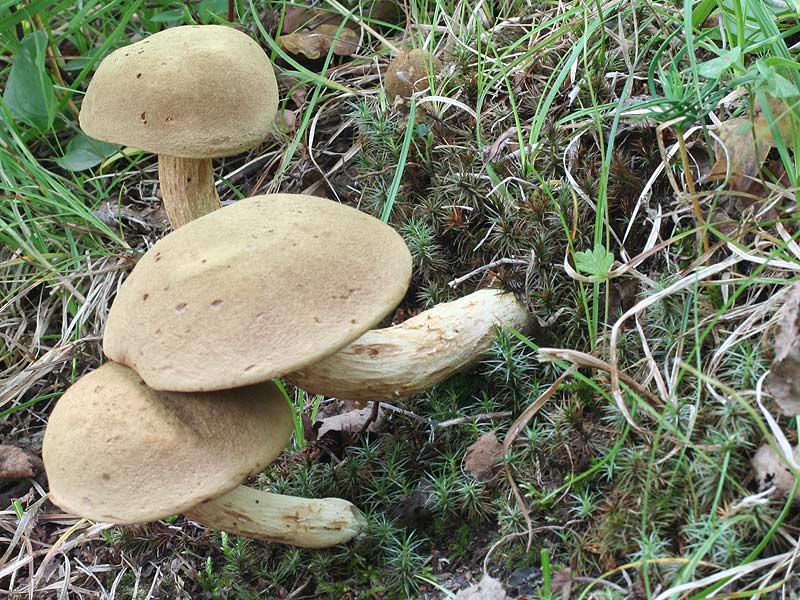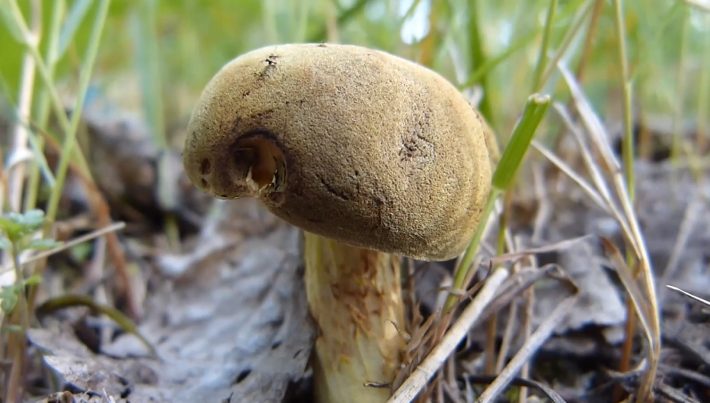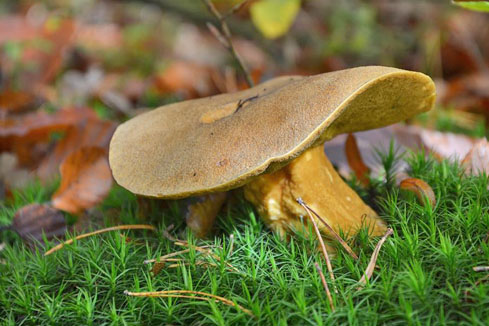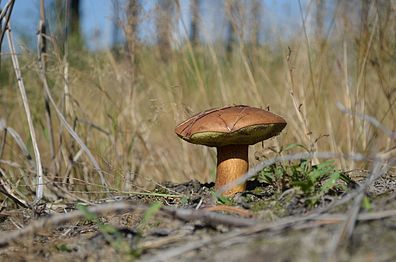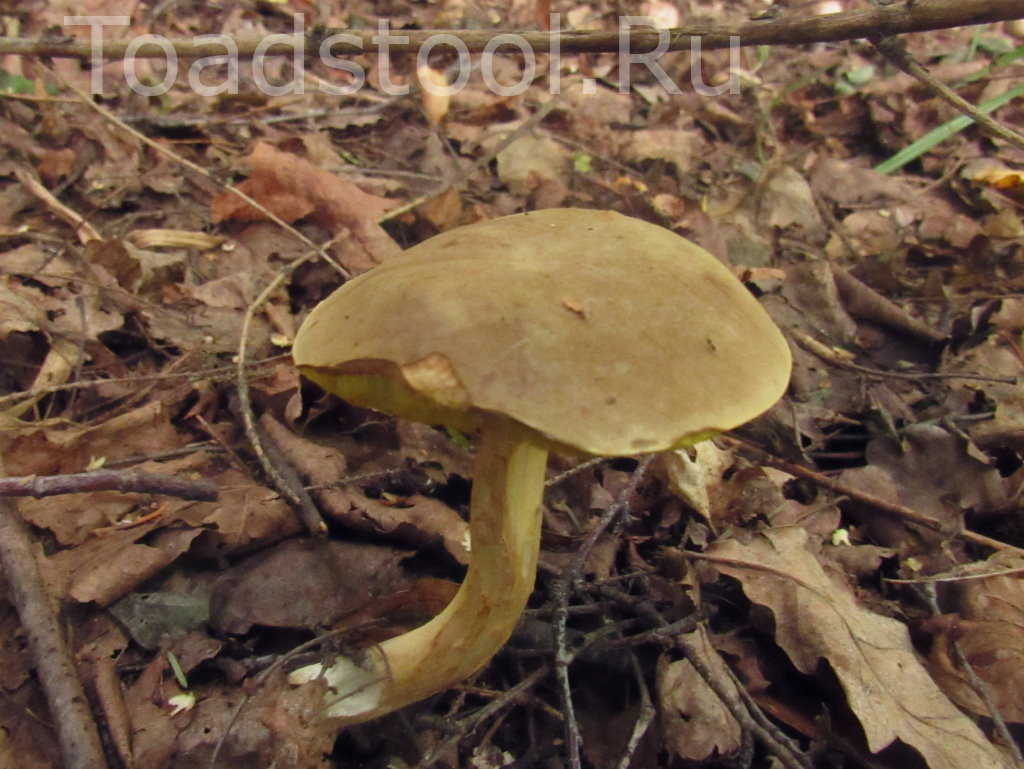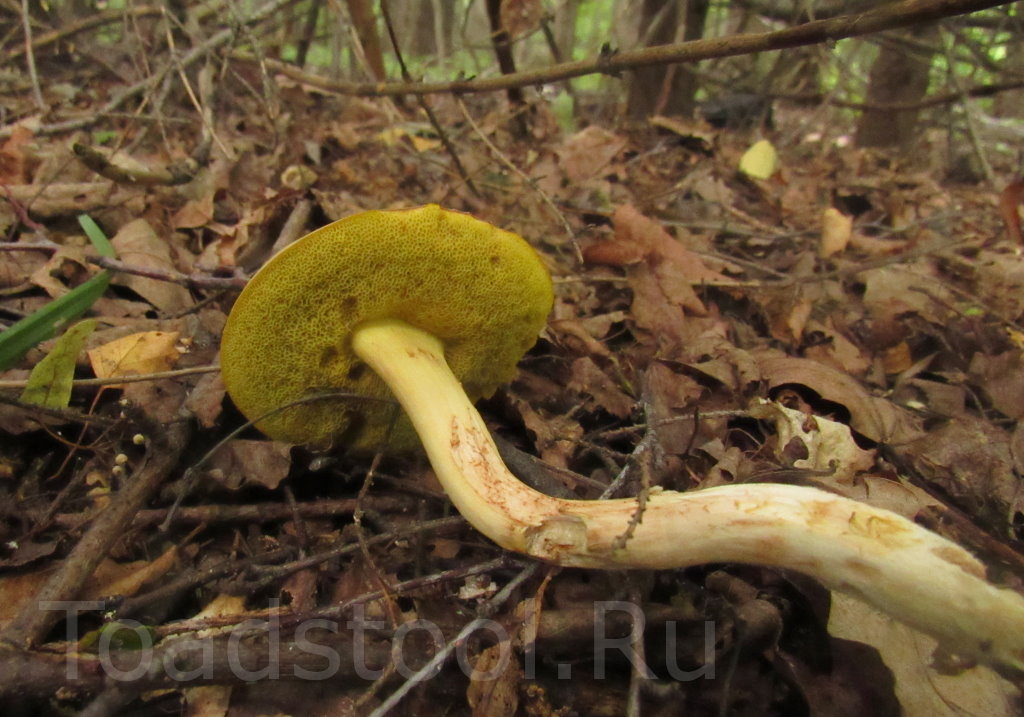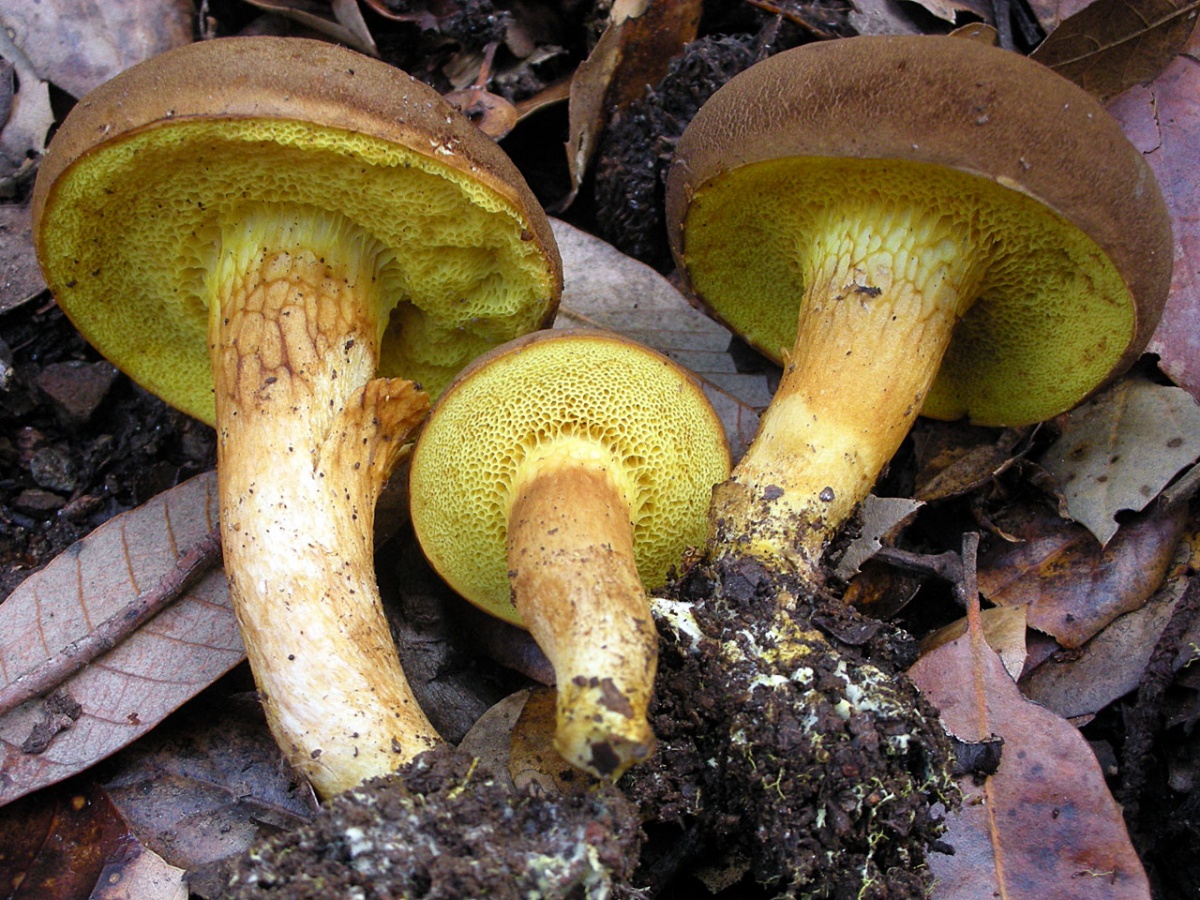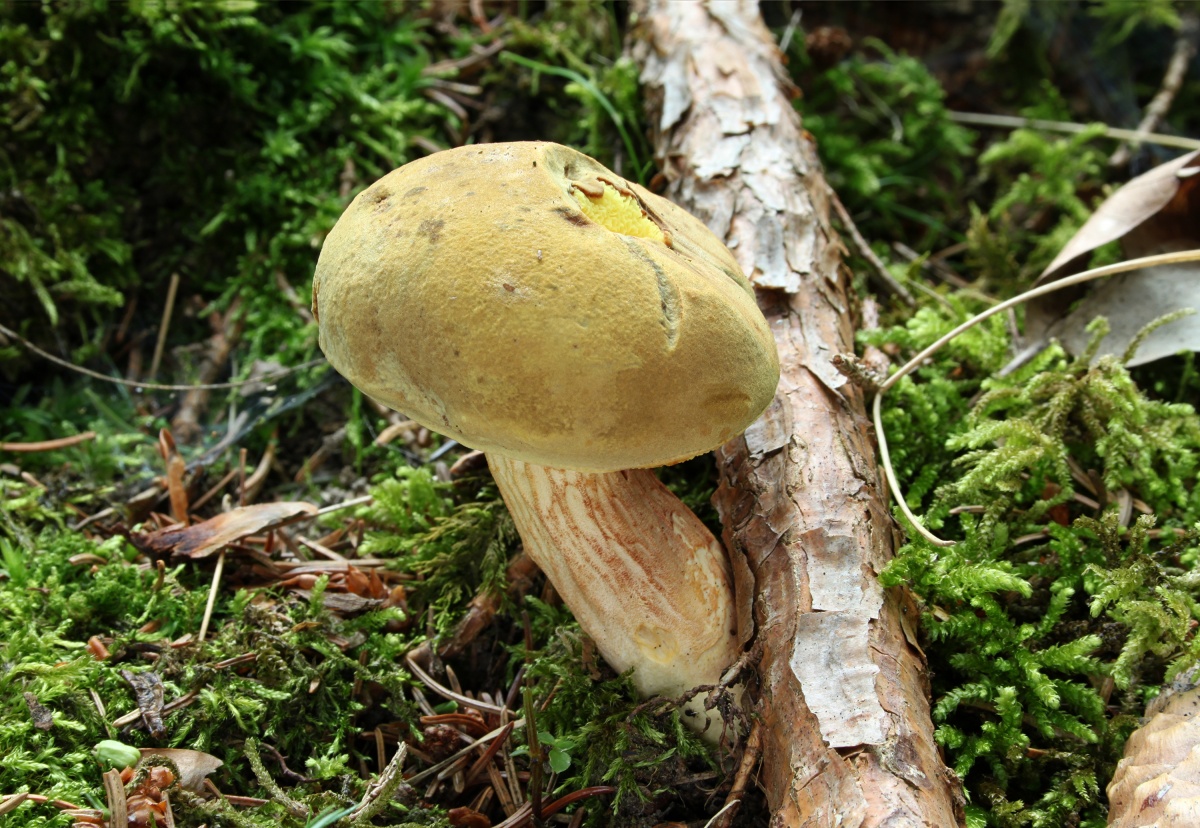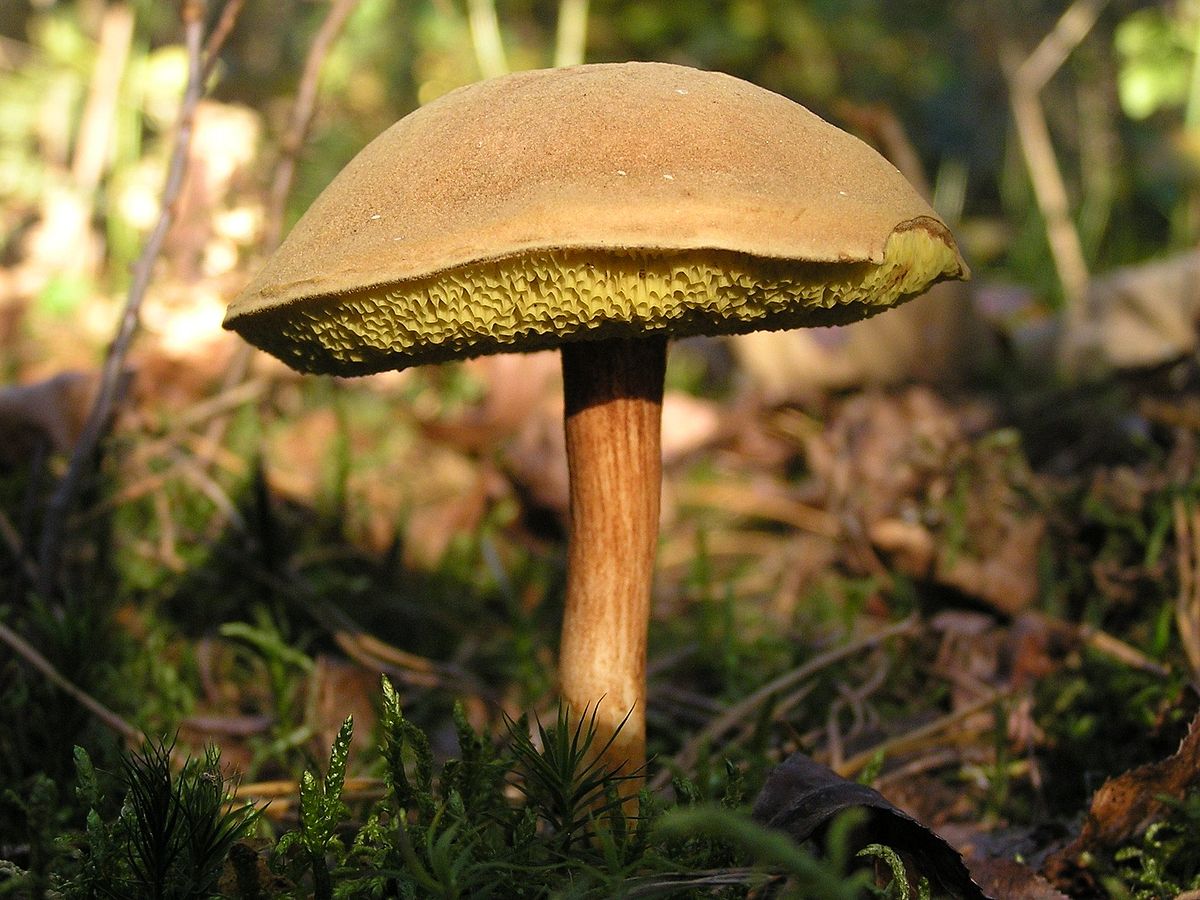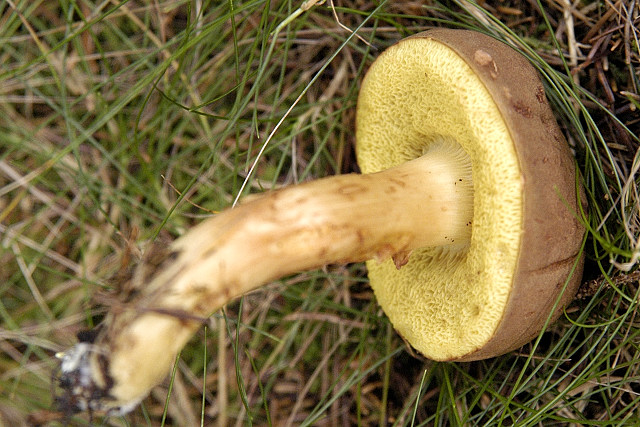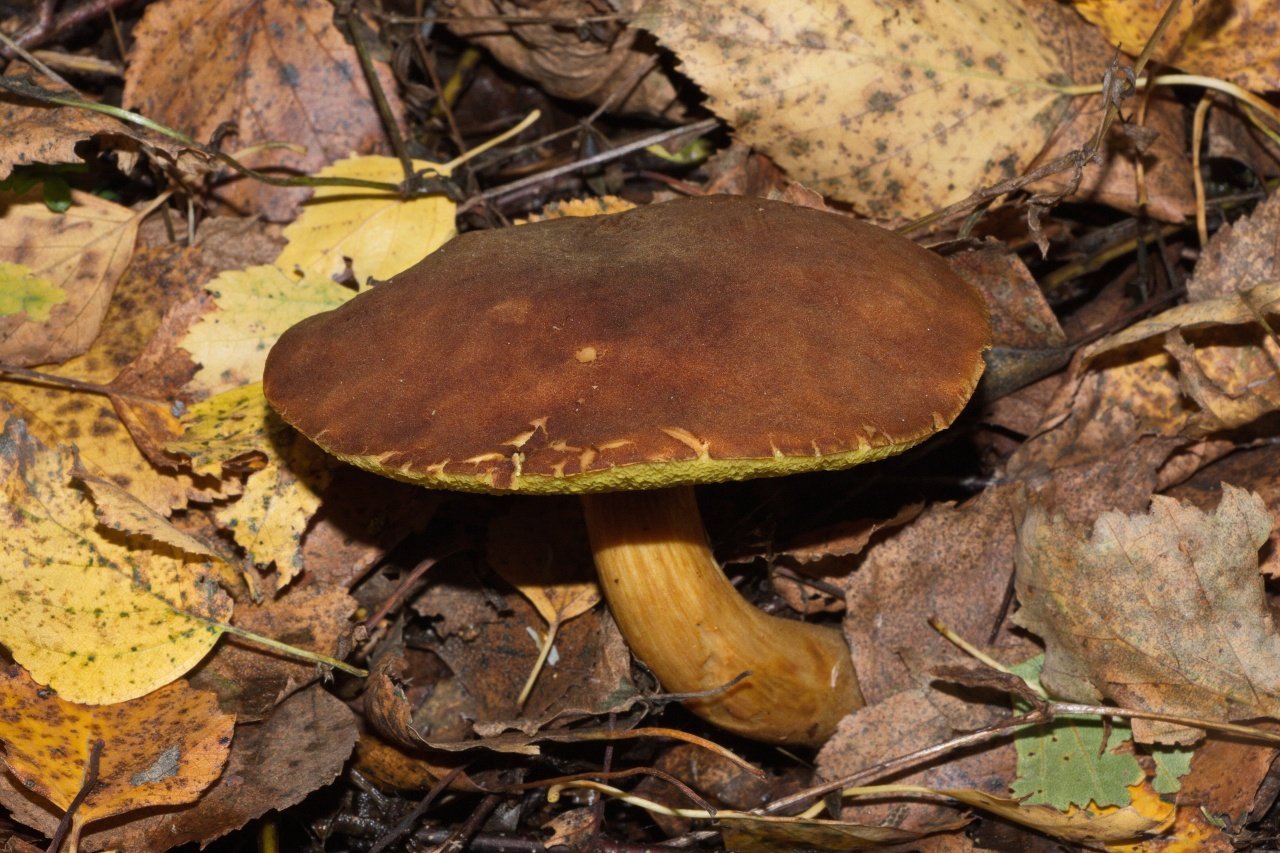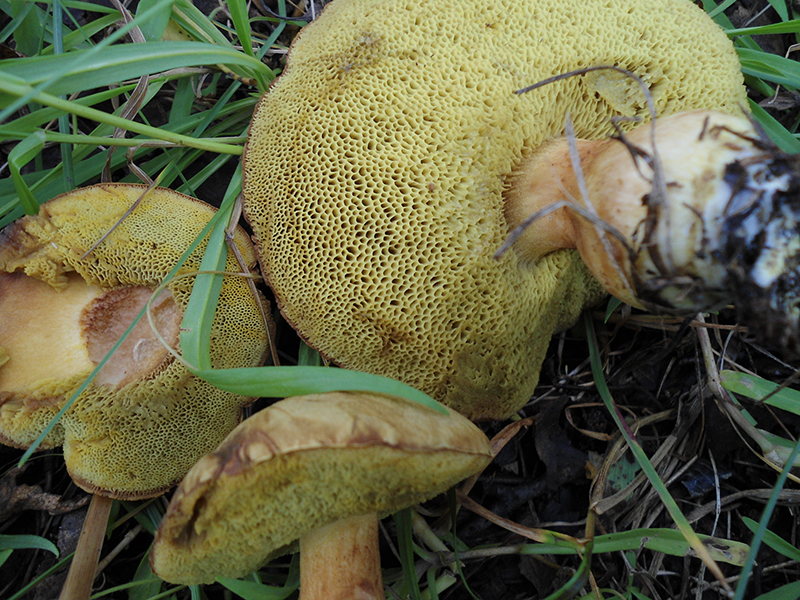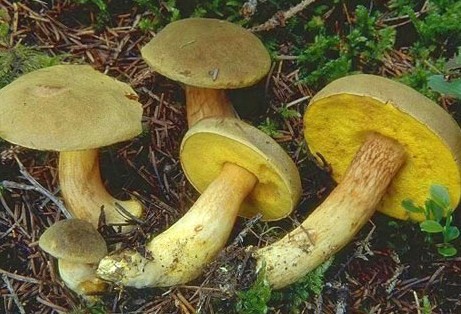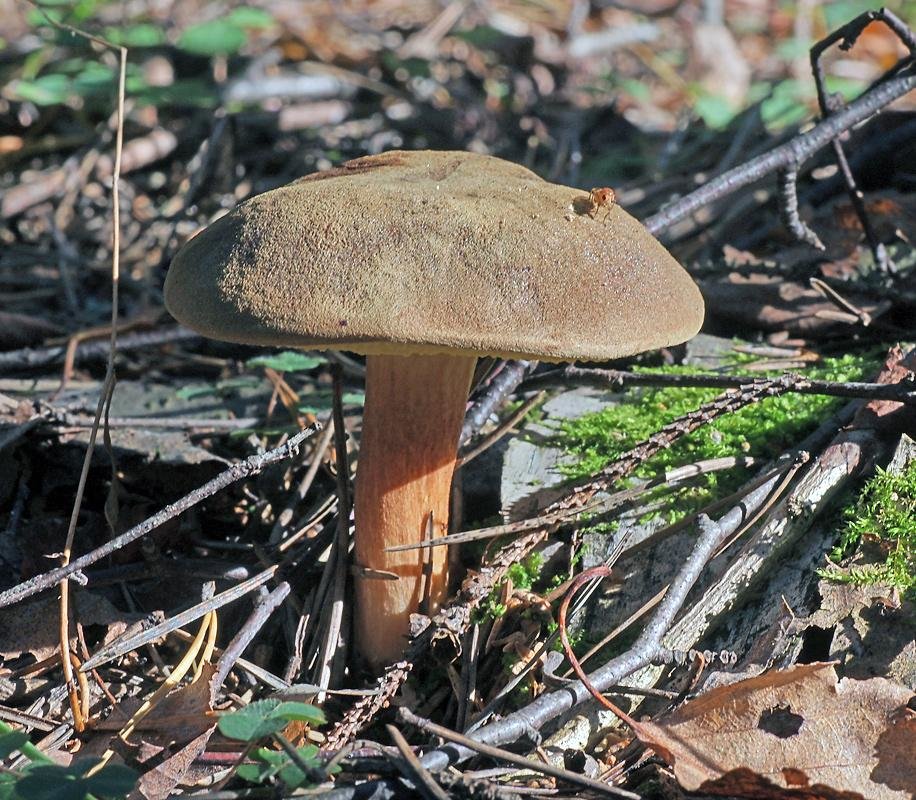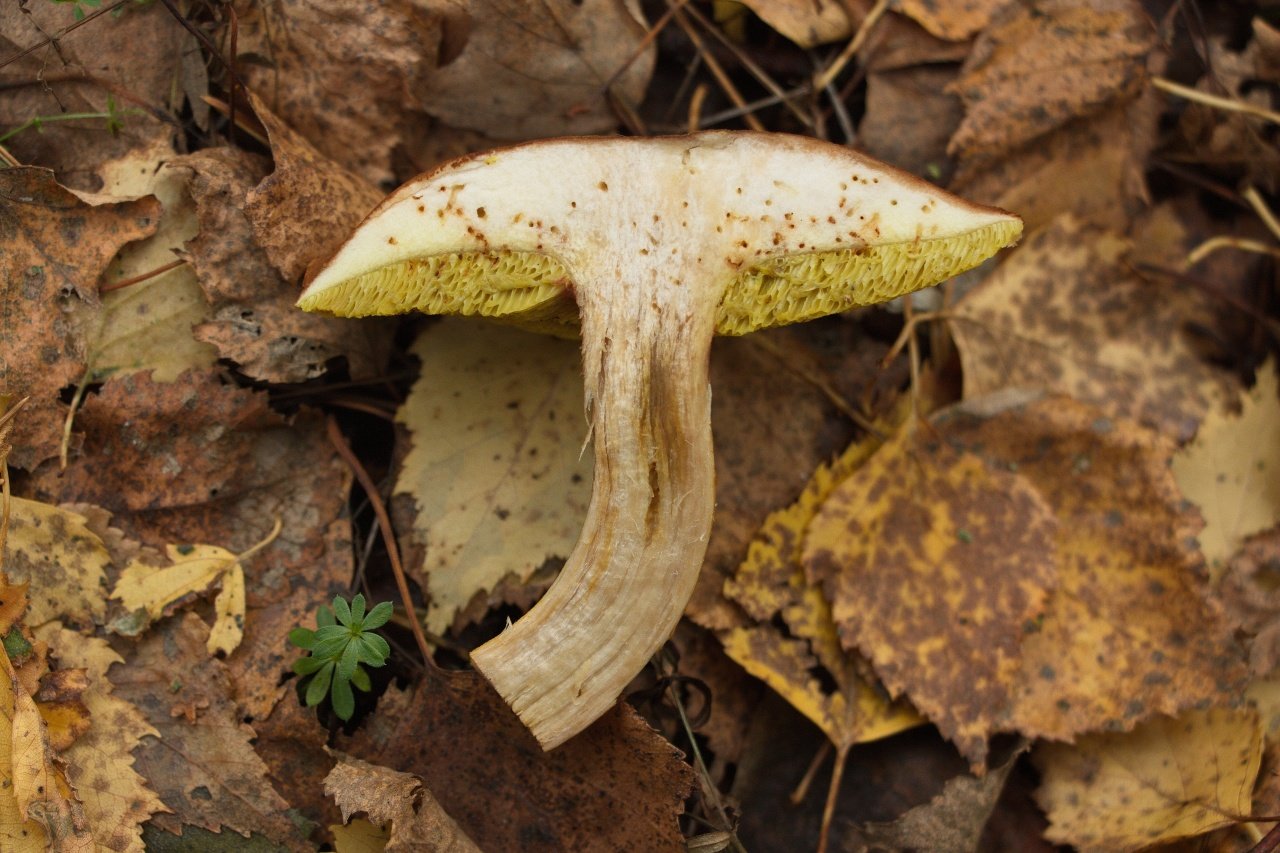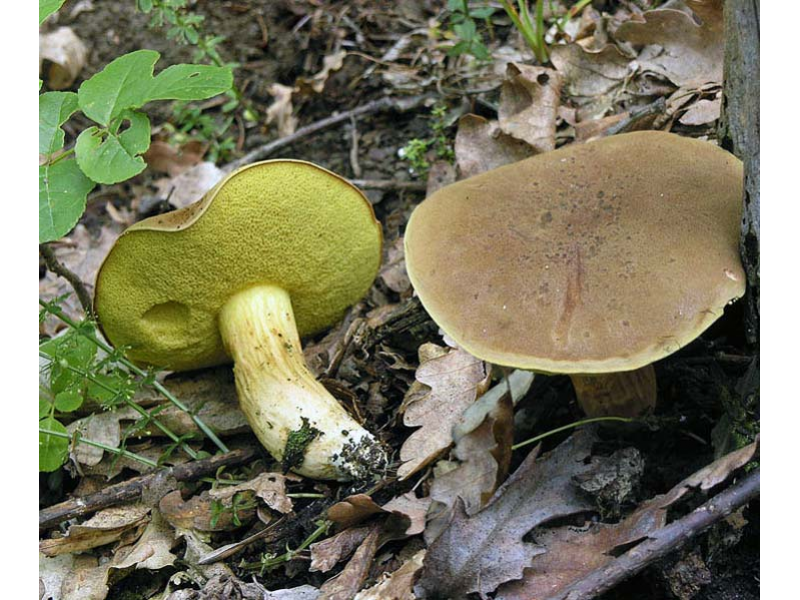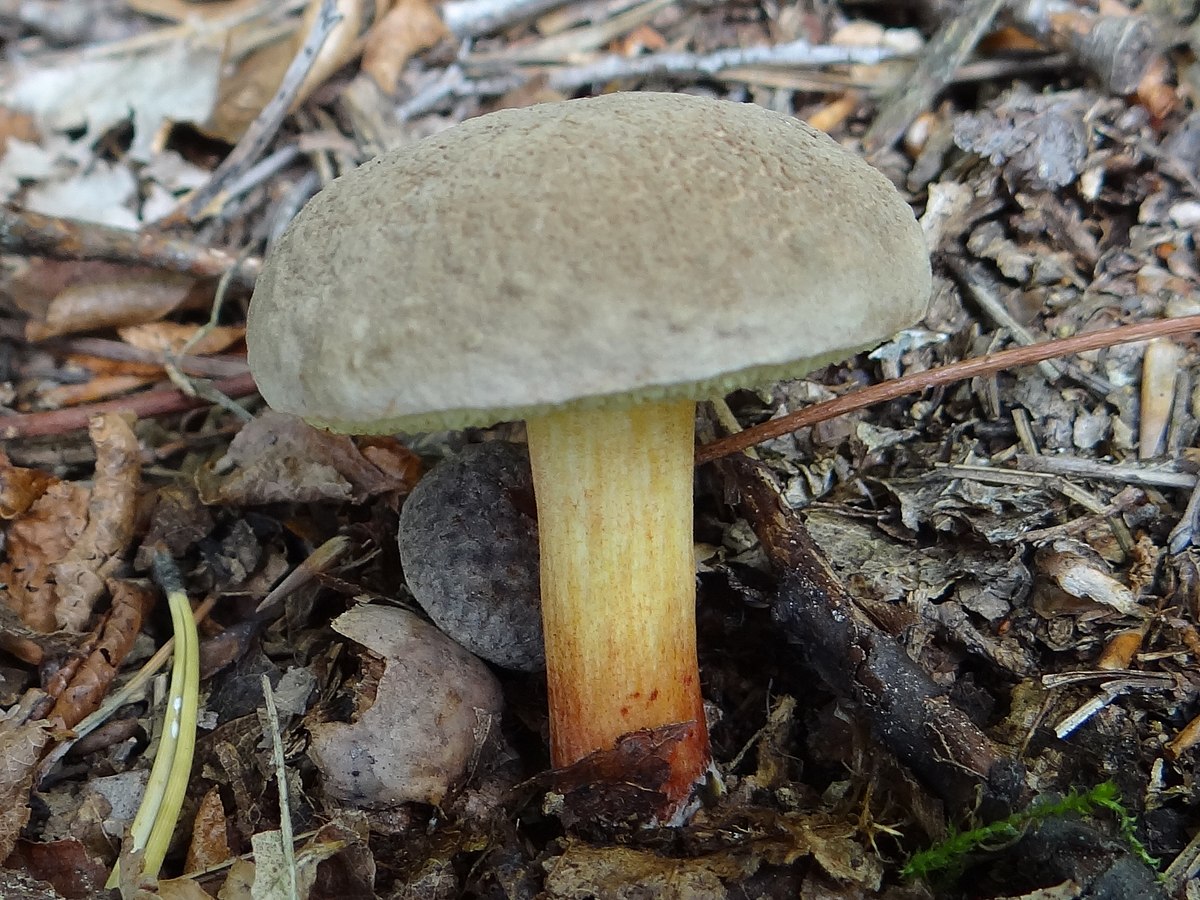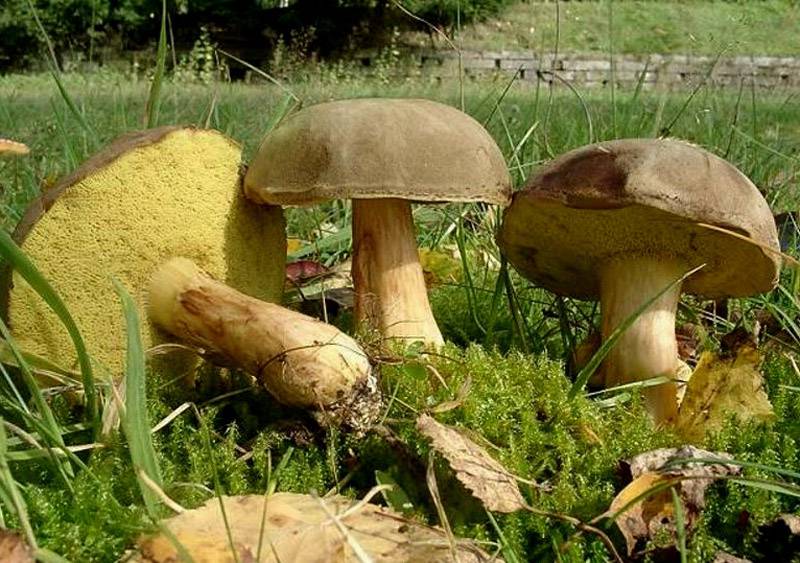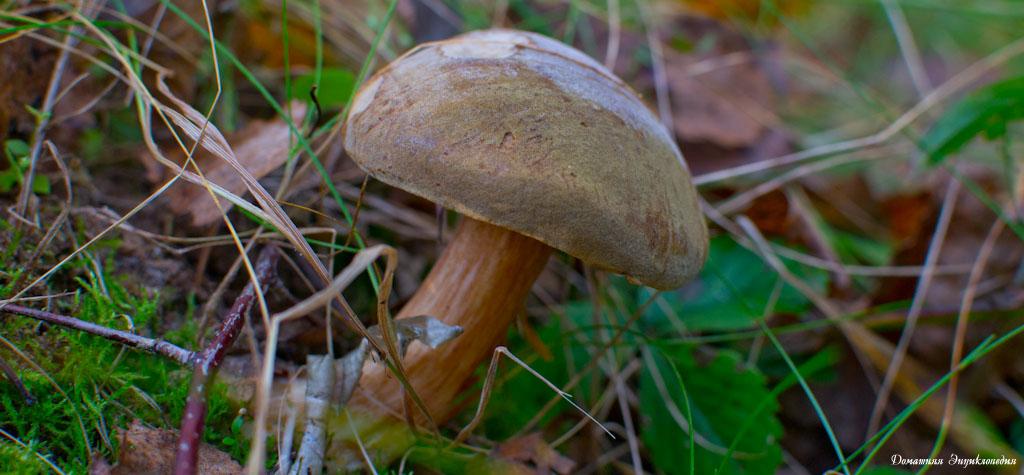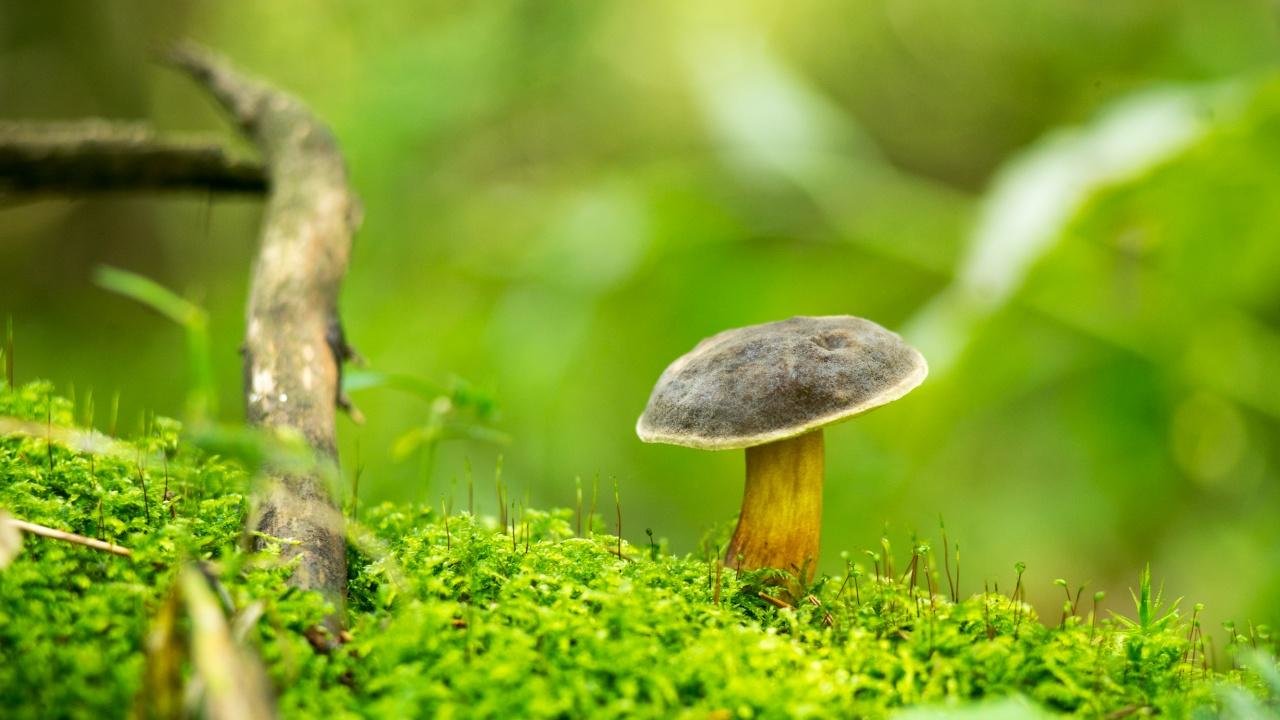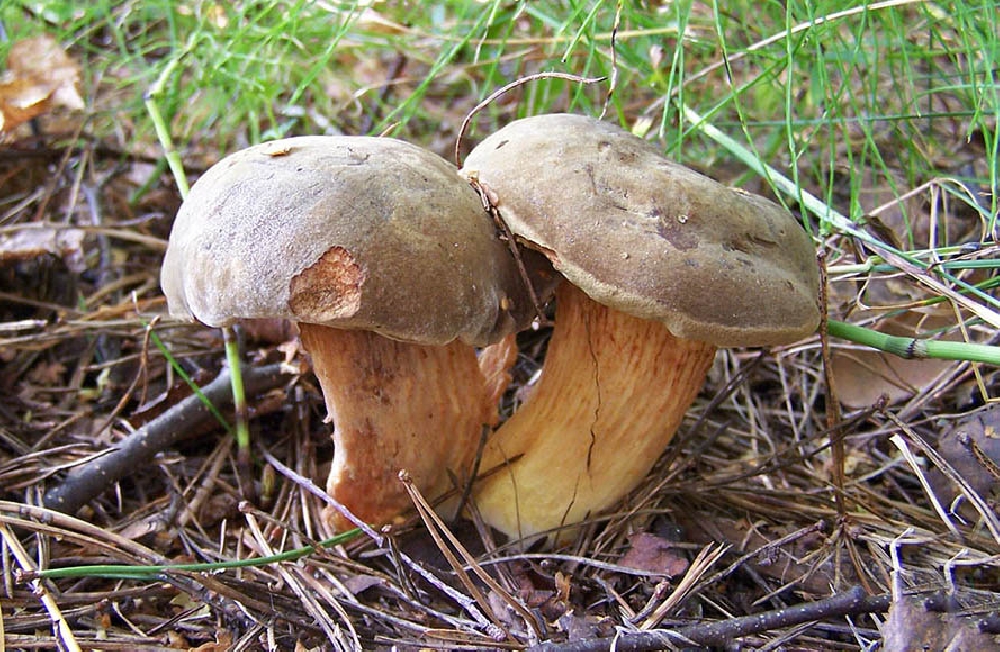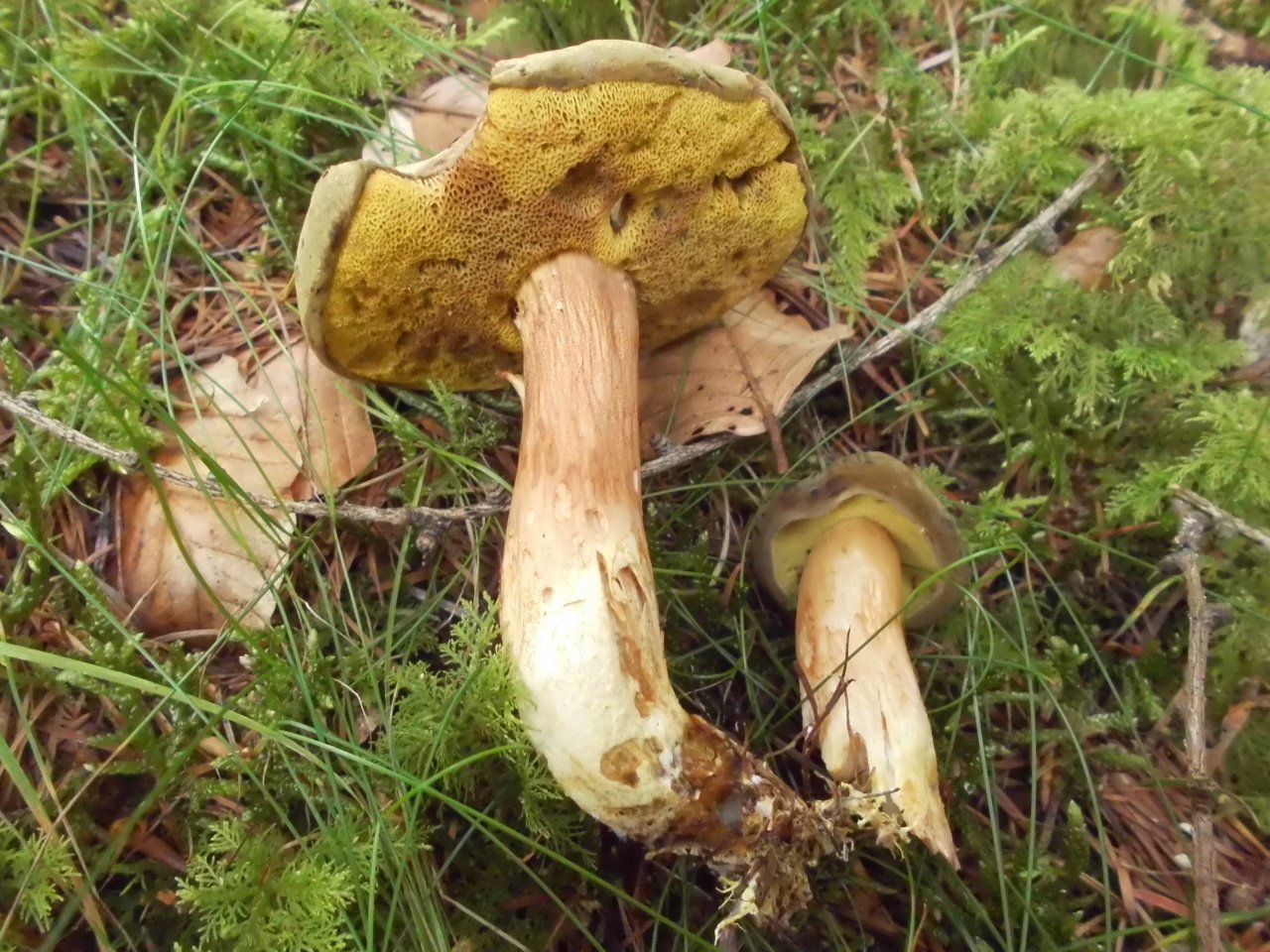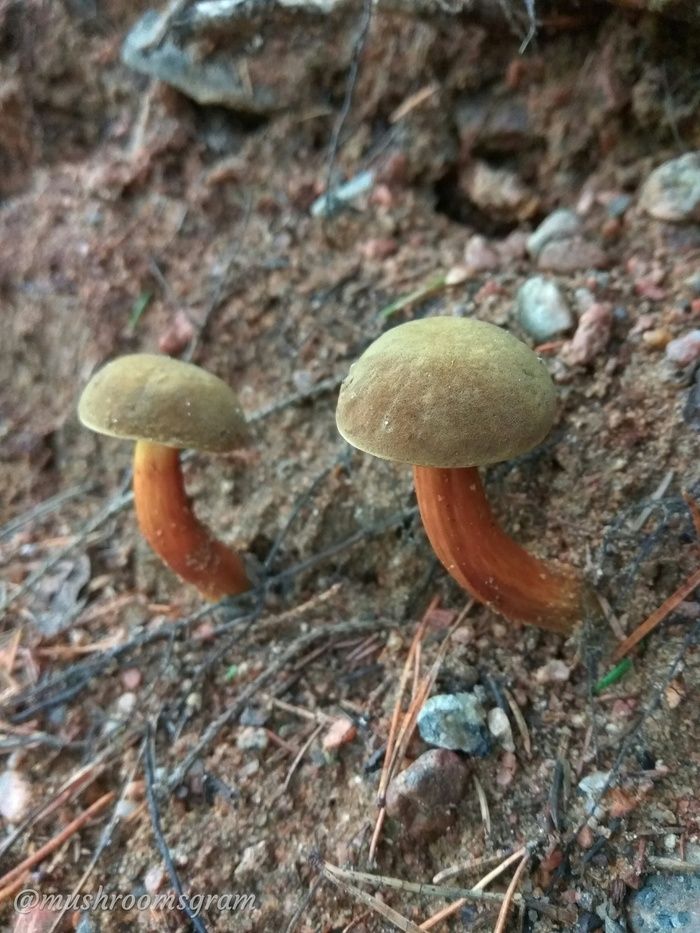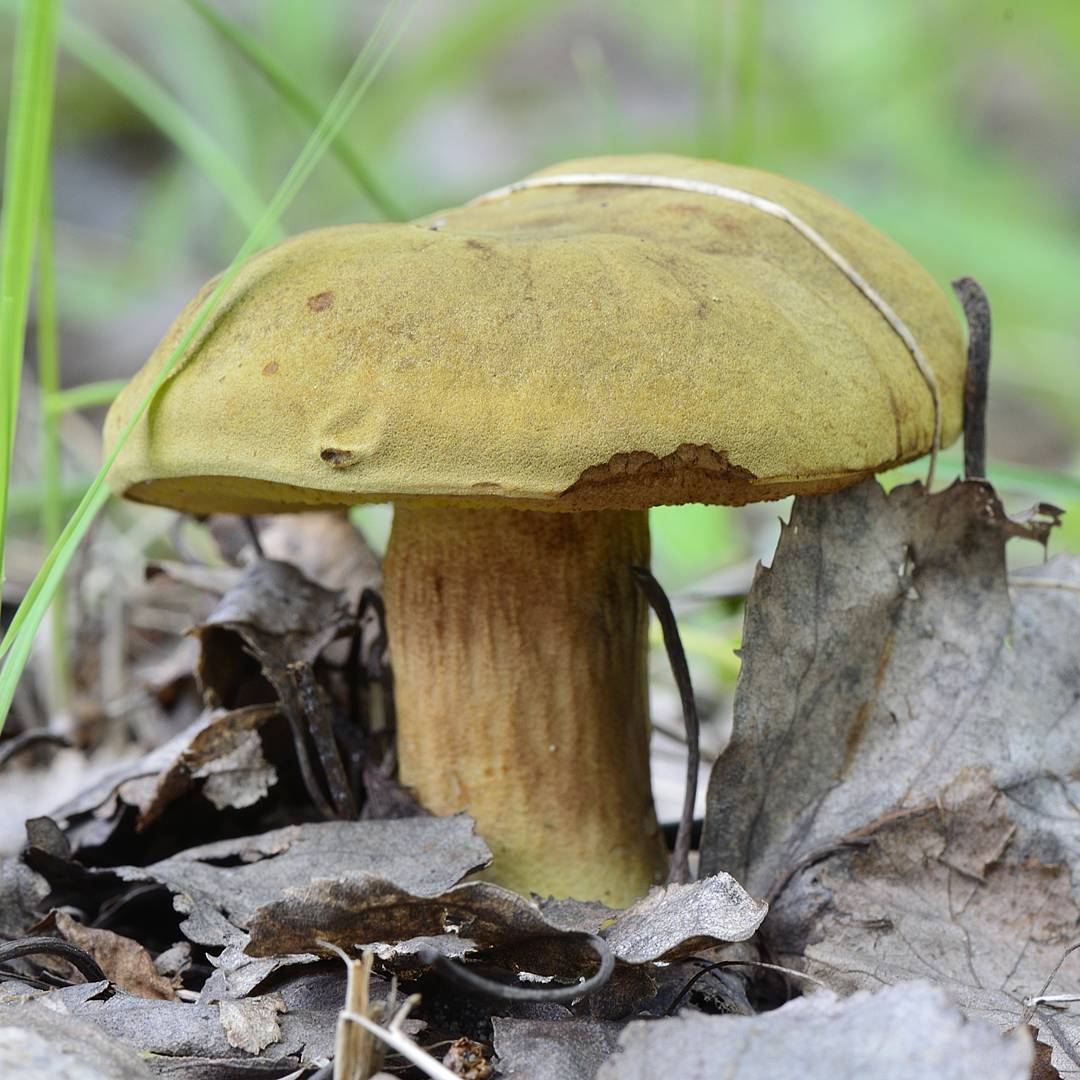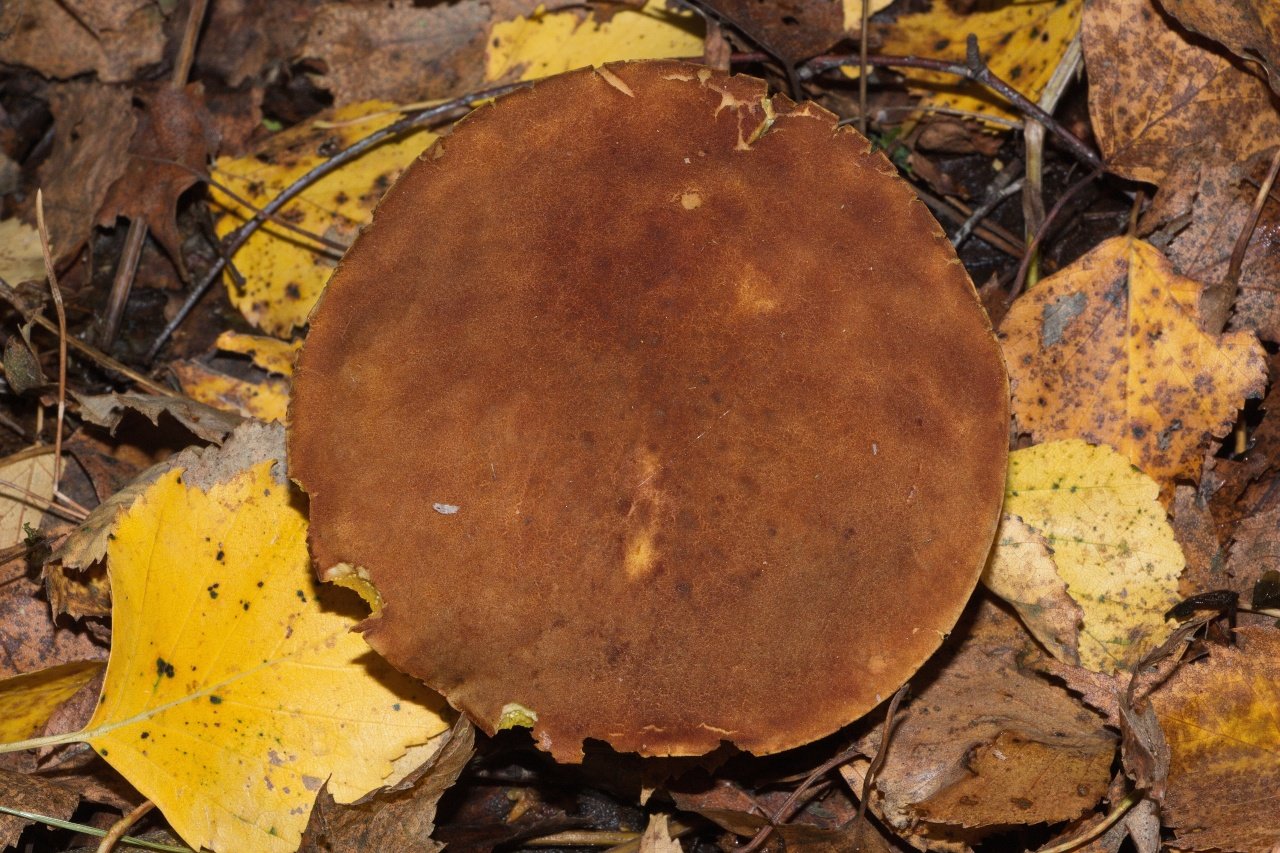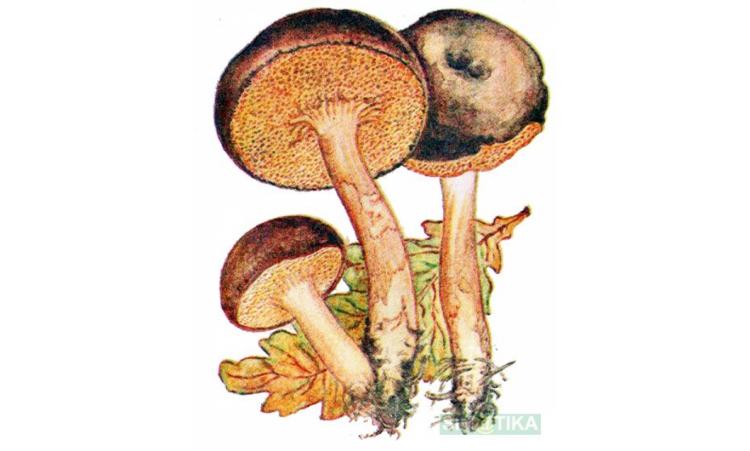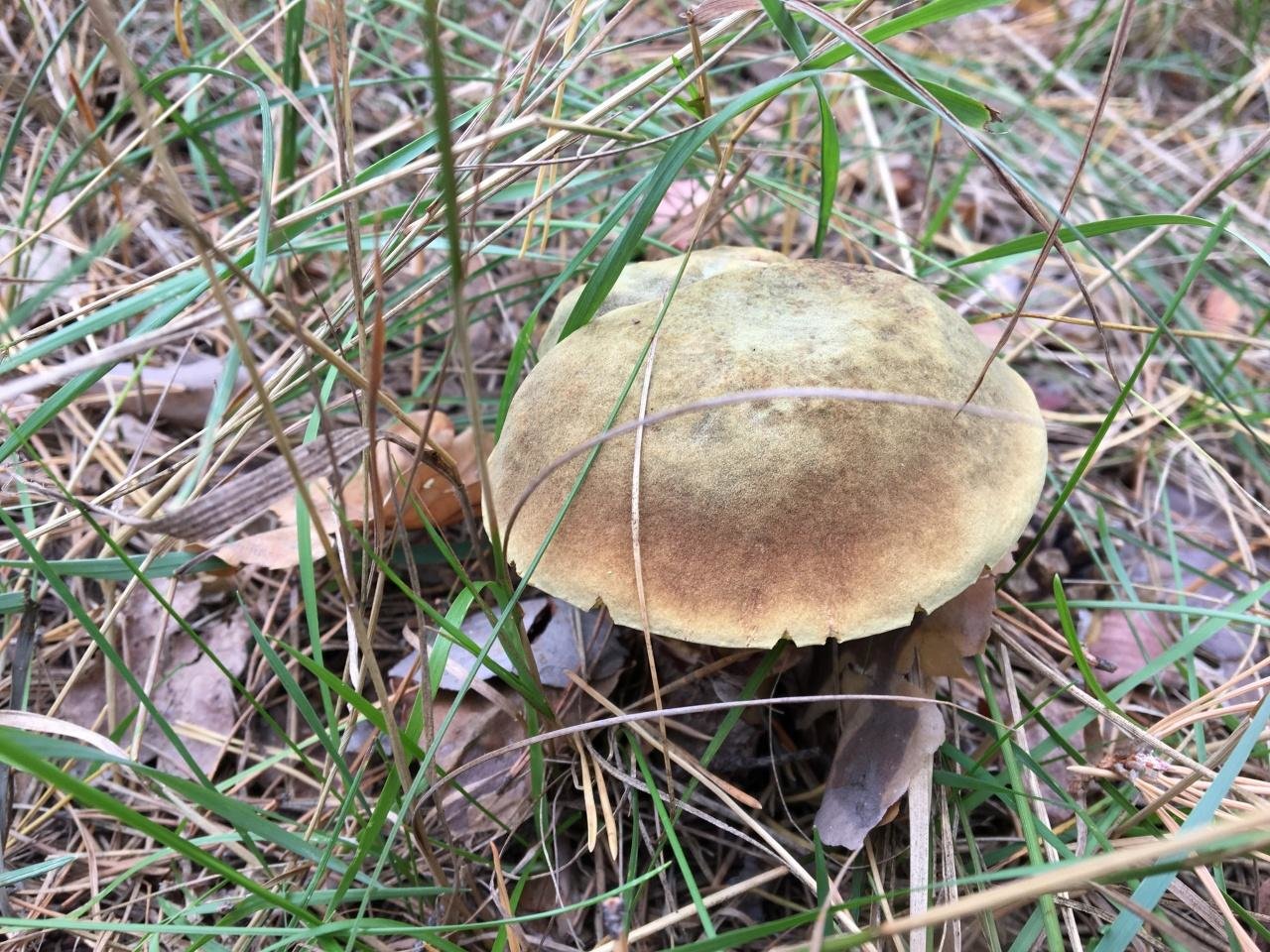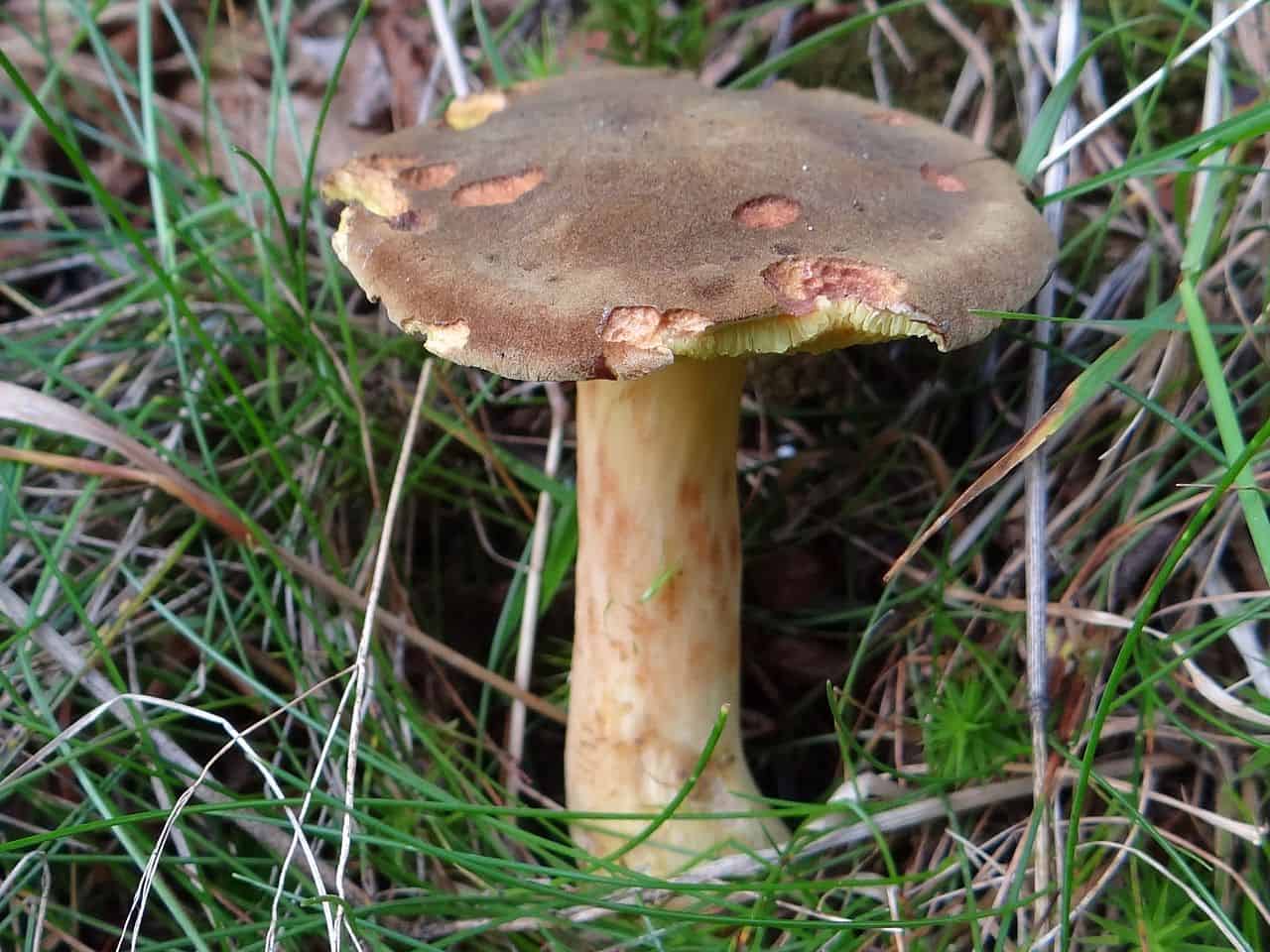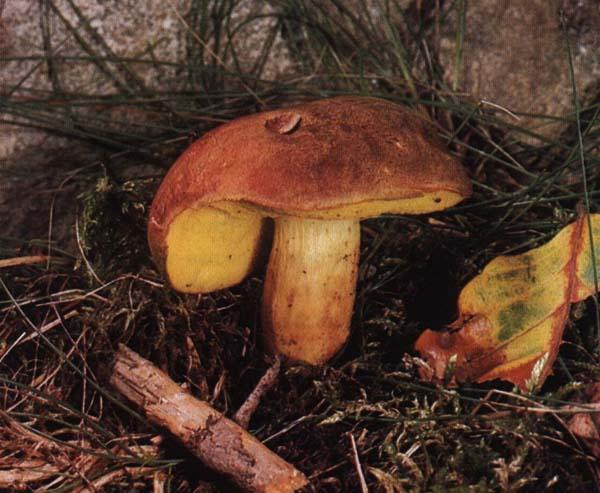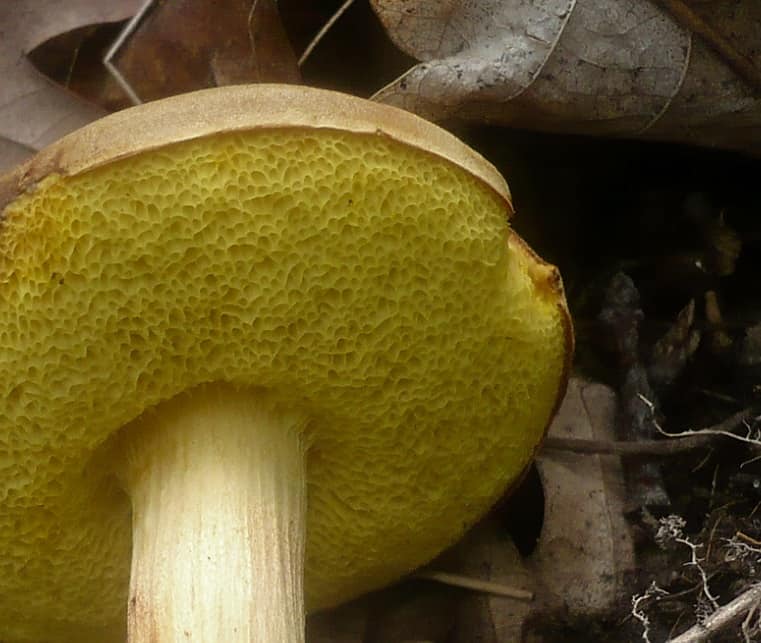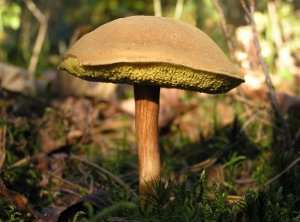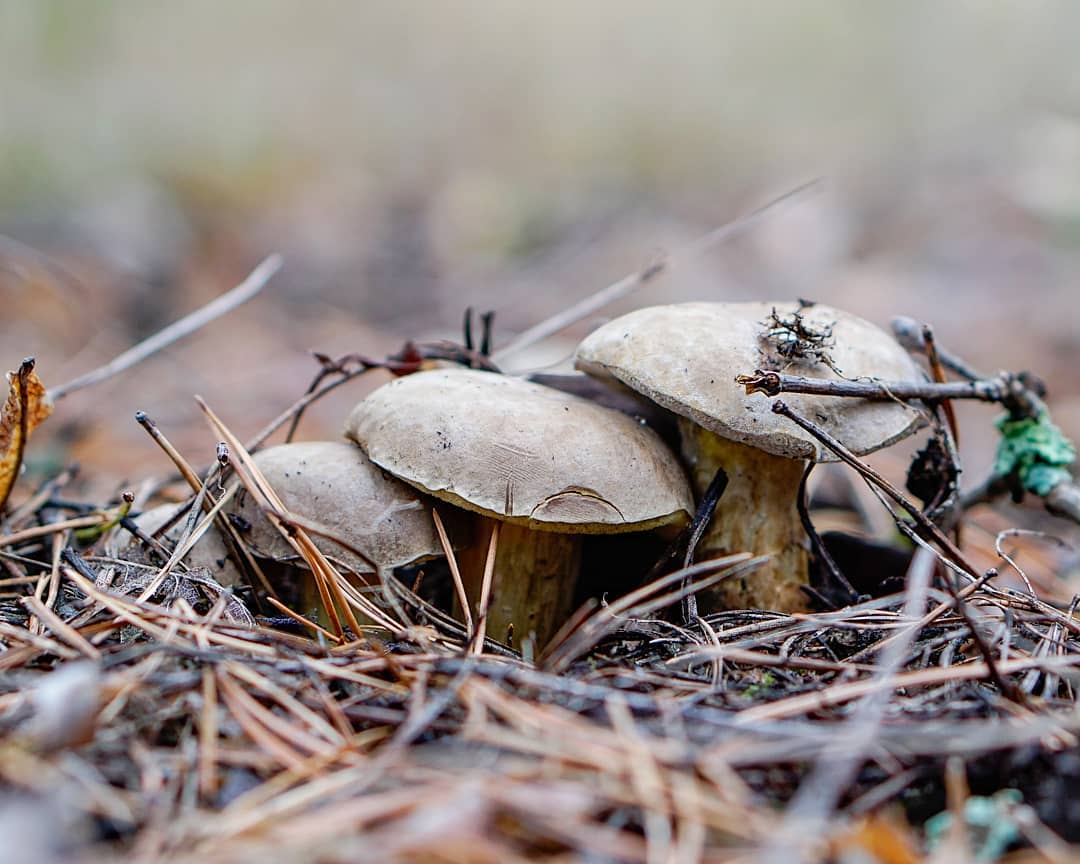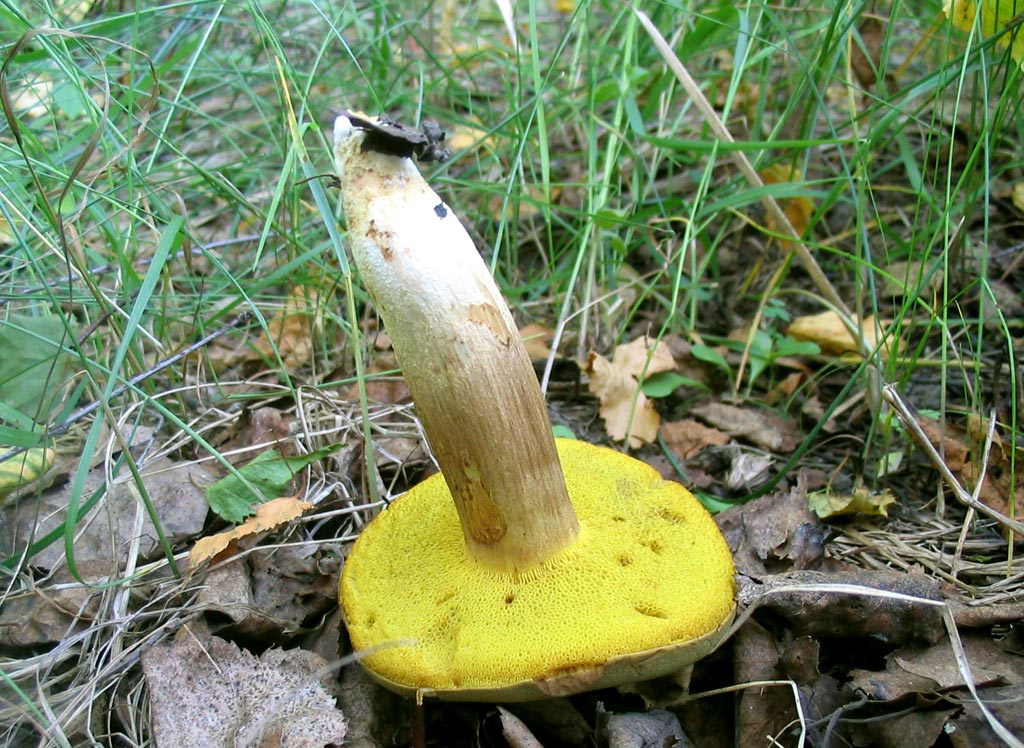Description of the green flywheel
The diameter of the cap reaches 12 centimeters. The hat is thick-fleshed, at first its shape is hemispherical, but then it becomes flat and thin. The surface of the cap is velvety or chamois-fleecy, with age it becomes dry and almost bare, and can become covered with cracks.
The color of the cap is olive-brown. In damp weather, the cap becomes covered with white mold, which is characteristic of other tubular mushrooms.
The tubular layer is adherent, it is easily separated from the pulp. This layer is spongy with coarse, irregular, angular pores. At first, the pores are bright yellow, and then they turn greenish-yellow. The tubules are adherent, adherent to the peduncle.
The flesh of the green flywheel is rather loose; when broken, it turns slightly blue. The pulp has a mild fruity odor and a pleasant taste. The skin does not separate from the pulp. In young specimens, the flesh is very tough, but with age it becomes soft. Spore powder of olive brown color.
The length of the green flywheel leg reaches 10 centimeters, and the thickness is 2 centimeters. The leg is cylindrical, solid, most often curved, slightly narrowed in the lower part. The surface of the peduncle is granular fibrous or bare. The color is yellowish, but can be reddish. In the upper part of the leg there is a brown mesh pattern. The flesh at the stem is fibrous and firm.
Growing places of green flywheel
These mushrooms are found in coniferous and deciduous forests, among shrubs. Most often, green mushrooms can be seen in well-lit places: on the edges, paths, along the sides of ditches. Sometimes these fungi can grow on ant hills and rotten wood. They grow, as a rule, singly, but sometimes they are found in groups.
Green moss in cooking
This mushroom is considered edible, according to its taste, it belongs to the second category. All parts of the mushroom are suitable for food, that is, both the cap and the leg.
Green flywheel is prepared without preliminary boiling, but it is imperative to peel off the skin. Also, green mushrooms can be pickled and salted, they are well stored.
It is impossible to eat old green mushrooms, since they already begin to break down protein, which leads to severe food poisoning. That is, only young specimens are used for cooking.
Green flywheels are well known to both professionals and novice mushroom pickers. The taste qualities of these mushrooms are quite high.
Similar species
Green flywheel has external similarities with the Polish mushroom and the yellow-brown flywheel, which are edible, as well as the pepper mushroom, which is classified as conditionally edible mushroom, since its pulp has a pungent bitterness.
A yellow-brown flywheel or a yellow-brown oiler has first a semicircular and then a pillow-shaped cap, with a diameter of 5 to 14 centimeters. The color is first gray-orange or olive, and then becomes brown-red. These mushrooms grow on sandy soils, meeting from June to November. They grow in Europe and Russia.
In terms of taste, they are classified as edible mushrooms of the 3rd category. These mushrooms are best suited for pickling.
The Polish mushroom grows in mixed and acidic soils. They can often be found in coniferous forests, in litter, in moss, under beeches, oaks and chestnuts. Grow singly or in large groups. The season is from July to November. Polish mushrooms grow in Western Europe and in our country.
The diameter of the cap of the Polish mushroom ranges from 3 to 12 centimeters. At first, the shape is hemispherical, and then it becomes flat. The color of the cap is reddish, brownish, chestnut, dark brown, olive and even black-brown. In wet weather, the cap of the Polish mushroom becomes covered with mucus. The pulp of the mushroom gives off a pleasant fruity aroma; it is dense and fleshy to the touch.
The pepper mushroom is definitely not poisonous. Many people claim that pepper mushrooms have a bitter taste. But this is a controversial statement, for example, the gall mushroom is very tasteless, and the pepper mushroom has a spicy taste, while pleasant. The diameter of the cap ranges from 2 to 6 centimeters. Its surface is dry and velvety. The mushroom has a faint peppery smell and a rather pungent peppery taste.
These mushrooms are most commonly found in coniferous forests from summer to autumn. In addition, pepper fungi can form mycorrhiza with young birches and deciduous trees.
How to make a font
Of the two options for a wooden bath-pool, it is best to choose a round version, like the Japanese bath ofuro.
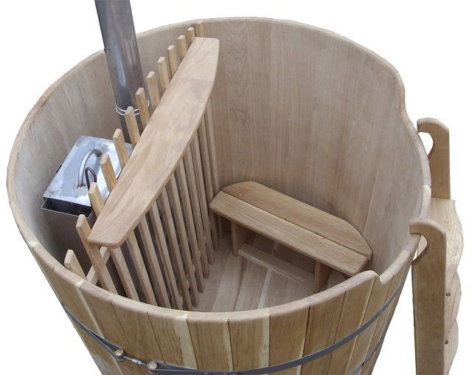
A classic model of a Japanese bath heated by a submersible oven
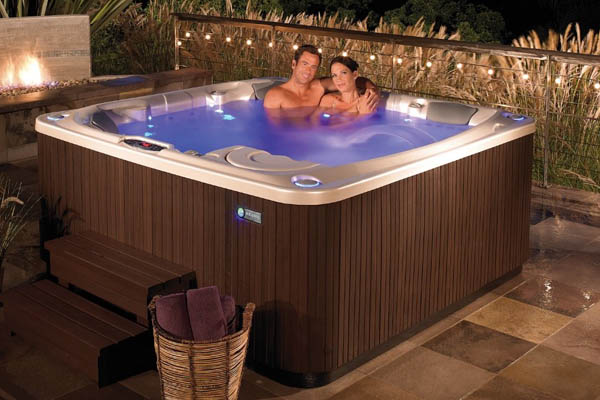
There may be many reasons for such a decision, we will give only a few, the most important:
- Heating of water in a round tub of the font is faster and more even;
- The round body is easier and more convenient to carry on the ground, you can roll the container from home to the bath alone;
- The barrel provides good stability even on uneven ground, strong heating or even overheating of the water does not lead to leakage;
- The main thing is that the tightening hoops squeeze the strips of the walls of the round structure almost evenly, which cannot be said about the avalanche fonts.
False doubles
The green mosswheel has twins, the differences between which are clearly visible in the photo. How to distinguish between these types:
| Name | Hat and hymenophore | Leg | Danger |
Flywheel green |
Brown with a greenish tint | Cylindrical, with a dark mesh | Edible |
Motley moss |
The hat is burgundy, brown, ocher, cracks, and there is a pinkish tone in the cracks | Clavate, below the belts of gray on a red background | Edible |
Half white mushroom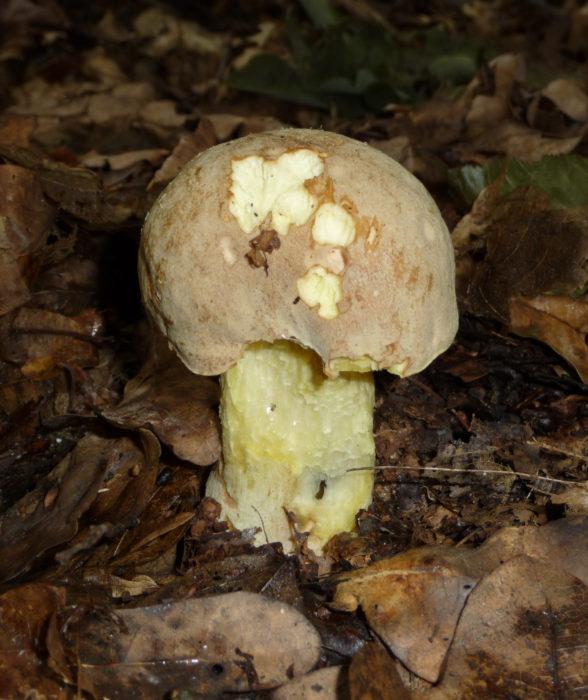 |
The pores of the tubular layer are very small | Thick massive, light yellow color, no mesh | Edible |
Flywheel dark brown |
Dark hat from yellow to brown and olive | The dark mesh is clearly visible, the color is olive, yellowish | Edible |
Pepper mushroom |
Copper-red, turns red when cut | The color completely matches the tone of the hat | Inedible, but not poisonous, has a pungent taste, bitter, sometimes referred to as conditionally edible |
Polish mushroom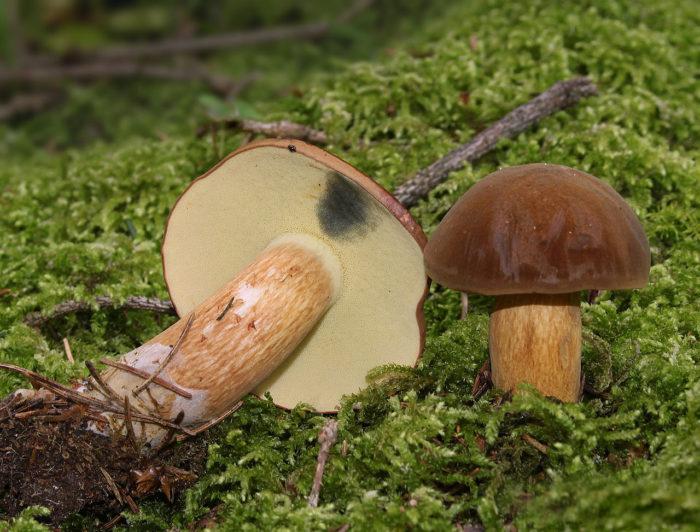 |
Brown, chestnut, chocolate | Brownish, but lighter than the cap, without a mesh, has a pattern with strokes along the entire surface | Edible |
This species of flywheel does not have poisonous and inedible counterparts. Of the most tasteless in the basket, there may be a pepper mushroom, but it will be bitter. Fortunately, they cannot be poisoned.
Characteristic features of flywheels
The Mosswheel has an easily recognizable cap: in young mushrooms, it is rounded, with a light golden-chocolate tint and a pale orange tubular layer; in older specimens, it is pillow-shaped or flat, cherry-brown in color, with a greenish-brown or yellow hymenophore. The surface of the cap is pleasant and velvety to the touch, sometimes cracked, in wet weather it is sticky. The leg is smooth or slightly wrinkled, without rings and veils. In those mushrooms that grow in dry moss, it is elongated, in those growing among the lush green moss curtain, it is short and thick.
In the place of pressure on any part of the mushroom or on the cut, the flywheel has a characteristic blue discoloration, which distinguishes it from many other mushrooms.
Description of the edible mushroom
The green flywheel belongs to the genus of Moss of the Boletov family, the Latin name is Xerócomus subtomentósus. Sometimes it is referred to the genus Borovikov or Boletus, and in Latin it then sounds Boletus subtomentosus. In addition, there are synonyms: Leccinum subtomentosum, Rostkovites subtomentosus and Versipellis subtomentosus.
The hat can reach 16 cm in diameter, but, as a rule, it is found from 3 to 10 cm. It looks like a "pillow", convex, velvety to the touch. The color is brown with an olive or gray tint.
The hymenophore (lower part) is tubular, adherent, yellow, sometimes with an olive tint.From pressure, it takes on a bluish tint. In adult mature fungi, the pores are large, their angular structure is visible.
The pulp is white, more often it does not change color on the cut, but it can acquire blue, turn blue.
The leg is in the shape of a cylinder, often tapering downward. It reaches 10 cm in height and up to 2 cm in diameter. The surface is smooth, fibrous, covered with a dark brown mesh. The spores are brown, fusiform.
Lucien Kele (founder of the French Mycological Society), discovered several types of mushrooms, one of which was the green flywheel. In total, the scientist described about 200 subspecies.
DIY heated hot tub on the street
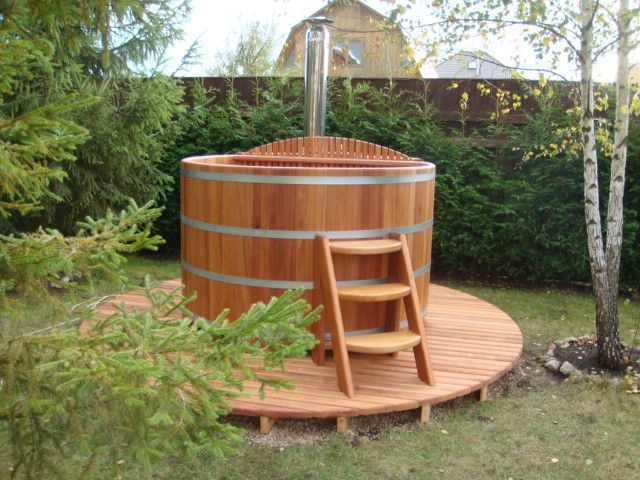
Inflatable. They are very easy to install, take up little space on the site, the price for them does not bite at all. Of course, unlike portable and stationary models, they do not look so presentable, but with the correct design of the recreation area, they harmoniously fit into the landscape.
Stationary. These models, when mounted, go deep into the ground. The entire hydraulic system, ensuring the functionality of the product, is located under the bowl or in the technical room. Depending on the circulation of water, stationary models are divided into: overflow (they have a simpler design, there is no high pressure) and skimmer (water is supplied under pressure through nozzles).
They can be used all year round. This is very handy, as most people love to enjoy a dip in the hot tubs when it is already snowing around.
Portable. They are installed outdoors or indoors - the main thing is that communications can be connected. If desired, they can be operated outdoors even in winter, as they are equipped with heating.

The choice of installation method for an outdoor bathtub is largely determined by the design of the bowl, its size and the way the water is heated. For wooden structures, a stone-paved platform is traditionally used, while the baptismal font must necessarily rise above the covering, at least 10-15 cm, so that the bottom part gets rid of condensation.
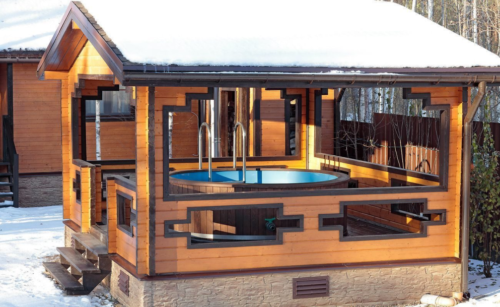
Plastic hot tub under a canopy
Plastic outdoor fonts are installed on a frame, usually metal, but it can also be made of brick, made of silicate bricks or rubble stone. About half of all polypropylene fonts are installed in a pit, in the form of mini-pools, in this case it is necessary to insulate, reinforce, plaster the walls of the pit in order to avoid the accumulation of ground moisture.
A steel bowl is traditionally installed either on poles - supports, or suspended from chains. A cast-iron font has to be laid on a stone or brick frame. All this requires thorough preparation and capital expenditures, not to mention outdoor heating. Therefore, such a heated font on the street is built mainly in private households, in semi-closed annexes and verandas.
Even with the most careful care, a cast iron boiler always rusts without water, has a peculiarity to get your hands and things dirty, so it is better to buy a cast iron hot tub with a special oxide coating that improves heating and reduces corrosion.
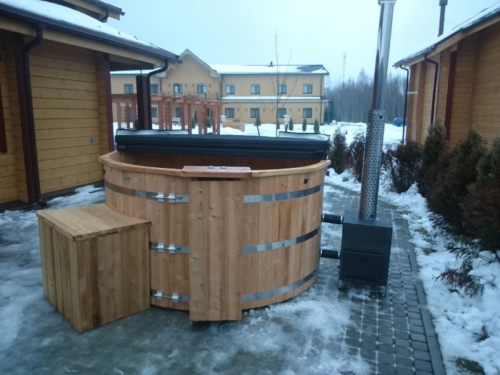
Finnish version of the heated barrel
The easiest way to install an outdoor bathing tank is to equip a supporting frame. In order to eliminate the risk of the bowl overturning, the container must be supported by at least 3-4 points. A rectangular or square hot tub can be installed on 4 massive beams, mounted in the form of a lattice on brick supports.

Street font embedded in the deck flooring
How do hot water bath tubs work?
Oddly enough, a heated outdoor bath only provides the necessary relaxation effect for muscles and nervous system in cold or cool air and open space. The higher the contrast, the stronger the effect. Even in frosty conditions, taking into account the heating of the air and the warm water mist that accumulates over the font, a person feels extremely comfortable.
How to use a heated outdoor hot tub in the cold:
- A container, especially a plastic or cast-iron one, is thoroughly washed out of dust, the stove is melted, and the font is filled with water. As a result of heating the surrounding space, the steps and the platform are heated to a temperature that is comfortable for the feet;
- In an hour and a half, depending on the intensity of water heating, a warm fog appears over the font. You can take places in the font;
- The stove damper is closed, and at low speed the firebox provides constant heating and temperature.
The effect created by a street font with a stove is almost impossible to provide in a bath. Firstly, the warm atmosphere of the steam room cannot be compared with fresh outside air, and secondly, when the stove is operating at minimum heating, a certain amount of carbon monoxide is formed. In outdoor conditions, it does not pose a threat, but inside the bath it can be dangerous.

Mobile hot tub with propane stove
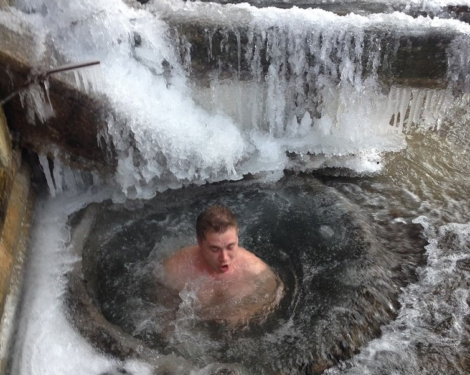
Icy street font
The worst situation is with wooden fonts, in which case the water has to be drained through an immersion hose, as in the case of an ordinary garden tank. It is better not even to try to cut the fitting into the bottom or a wooden wall, over time the wood will swell or dry out, and water leakage will surely appear.
Things are a little better with plastic barrels - fonts. Most of the containers are installed on a pre-prepared site, and the water is drained through a drain pipe welded into the bottom. You will have to lay an additional street sewer drain, it can also be used to drain the water after washing the font.
It is always difficult to drain water outdoors. If the wooden container is left to winter outside, then at least ¾ of the water volume will need to be drained, and a couple of pine or deciduous logs should be loaded into the remaining amount. Such a scheme does not allow the remaining water to rot and fill the mini-pool with a stinking smell, and in frost will not allow the frozen ice to deform the font.
False flyworms and their photos
Amanita pantherina

Amanita pantherina
With their hats, the mushrooms vaguely resemble the poisonous mushroom Amanita pantherina. It is necessary to carefully consider their reverse side - in the flywheel it is tubular, in the fly agaric it is lamellar, and the outside surface of the cap of the poisonous mushroom is distinguished by small white flakes that easily crumble.
Parasitic flywheel (X. parasiticus)

Parasitic flywheel (X. parasiticus)
It is easy to confuse it with young green mushrooms, if you do not know the conditions for its growth. The parasitic fungus is small in size - a cap up to 5 cm in diameter, lives on the body of a pseudo-raincoat and is extremely rare. In addition, it lacks a characteristic blue discoloration on the cut and an expressionless smell and taste. Although it is considered non-poisonous, no mushroom picker will put it in a basket.
Pepper Mushroom (Chalciporus piperatus)

Pepper Mushroom (Chalciporus piperatus)
A poisonous pepper mushroom (Chalciporus piperatus) looks like a red flywheel, which has a cherry-reddish tint of the leg and tubular layer. On the cut, both the cap and the leg turn pink, in contrast to the moss blue.
Gall mushroom (Tylopilus felleus)

They are more often confused with young boletus and boletus mushrooms than with mushrooms, but there is still a chance of getting into the company of mushrooms. Although the gall mushroom is not poisonous, its bitter taste, which appears during heat treatment, will spoil any mushroom dish.
Chestnut Mushroom (Gyroporus castaneus)

Chestnut Mushroom (Gyroporus castaneus)
The variegated flywheel also has an inedible double - a chestnut mushroom, or chestnut gyroporus (Gyroporus castaneus) with the same brownish cap, which changes shades during maturation and becomes covered with a fine mesh of cracks in dry weather. It is distinguished by a hollow brownish leg, does not change color on the cut, which cannot be said about its relative, the blue gyroporus (G. cyanescens), less like a flywheel due to its grayish-brown or brownish-yellow cap. Both mushrooms are inedible and taste very bitter in dishes.
Differences from false, inedible mushrooms?
The edible flywheel has the ability to quickly turn blue at the cut or in the place where it was pressed, while the false one does not. Usually, false mushrooms have no smell or it is barely perceptible. The edible flywheel cannot be found on the mycelium of the false raincoat, while the "deceiver" loves such a neighborhood.
False flywheels look like this:
- The parasitic flywheel is characterized by its modest size. The convex, velvety and oily cap measuring 2-7 cm is colored yellow, brown or nutty. The pulp is pale yellow, odorless, unable to turn blue. The leg is solid, in the shape of a cylinder. Its height is 3-6 cm, thickness is 0.8-1.5 cm. The parasite is often found in a company with false raincoats.
- The pepper mushroom is colored in various shades of brown. The leg is lighter than the cap, at the base it is yellow. The dense and fragile flesh tastes like hot peppers. It is easier to recognize the mushroom by the brown-gray or yellow-gray cut of the pulp, which subsequently turns red.
- The cap of the gall fungus is larger in diameter than that of the edible. It can be 10 or even 15 cm. It looks like a hemisphere (in older ones, it is flatter). The surface is dry, and at high humidity it is sticky. The fruit body is brown, with a yellowish, brownish or sometimes chestnut tint. The white tubes of the hymenophore gradually turn pink, when pressed, they turn red.
A cylindrical or club-shaped leg reaches a height of 12 cm and a thickness of 3 cm. The pulp is odorless. Often the gall fungus grows at the base of trees and near rotten stumps, it is never wormy.
Distributed in Europe, North Africa, North America. Grows on pseudo-raincoats (genus Scleroderma). The season lasts summer and autumn. Rare view.
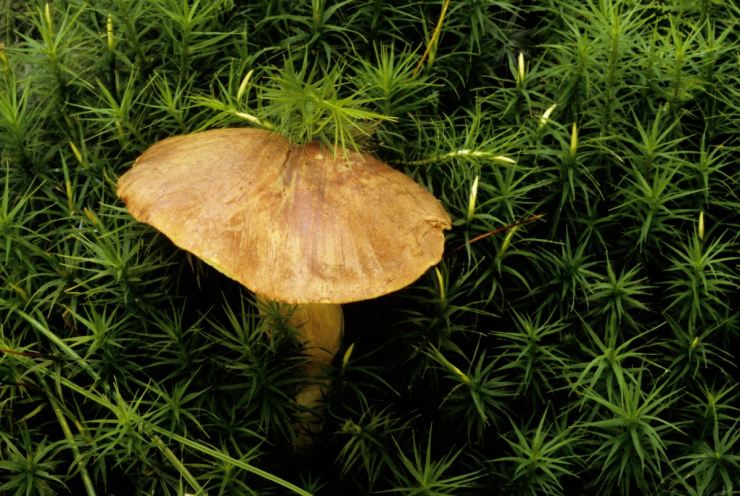
Inedible mushroom.
In addition, the cap of the fly agaric resembles the cap of the panther fly agaric, one of the most poisonous mushrooms. These mushrooms differ in the reverse side of the cap, it is tubular in the fly agaric, and in the fly agaric it is lamellar.
Collection times and rules
Flywheels enter the season of mass fruiting from July to the whole of September. However, each has its own terms. For example, the first fractured flywheels begin to appear in the last decade of June and can catch the eye of mushroom pickers until the end of September. The main collection of these mushrooms is carried out from the second half of August to the second half of September.
The Polish mushroom can be hunted quietly from June to November. It is often found when the season for other tubular mushrooms has ended. The harvest season of the green flywheel is May-October, the red one is August-September.
A good time of day for picking is early morning, before the sun warms up the mushrooms. In this case, they are stored for a long time.
When collecting mushrooms, each specimen must be carefully cut with a sharp knife at the base.
It is better to leave old and overgrown mushrooms in place. For a long time, they could well have accumulated substances harmful to humans. Each mushroom found and cut must be cleaned of soil, grass, foliage, needles and placed in a container for collection with the cap down for good preservation.
DIY wooden font, how to check the quality
When assembling, many craftsmen use dry powder for grouting the joints of wine barrels, no glue. After the first filling of the tub with water and heating in the bath, the glue peels off at the joints, like dextrin for gluing wallpaper.
The first thing to do after assembly is to back up the barrel. Before knocking out the hoops, it will be useful to roll in the walls of the font on the edge, illuminate with a lantern and look at the joints for a light. If a thin, barely noticeable light strip flickers somewhere, then you will need to lightly knock it out with a rubber mallet or mallet.
At the final stage, the barrel is sent to the bathhouse and rinsed several times with boiling water to warm up the walls, and only after half an hour can the hoops be fully tightened, after which it is believed that the font can be used.
Most common questions
Edible mushrooms can be recognized not only by their appearance, the main clue is the ability to turn blue.False flywheels are not particularly dangerous, but due to their poor taste, they are considered conditionally edible and often unsuitable for human consumption. The advantages of mushrooms are a long fruiting season and benefits for the human body.

A strong-looking adult mushroom mushroom is often confused with a boletus, a relative of the Boletov family, a young mushroom with a boletus, or even collect false mushrooms instead, but the edible mushroom has a significant difference, and lovers of "quiet hunting" need to know about it.
The moss got its name for its predominant habitat in mosses - in the forests of temperate latitudes of both hemispheres, on ravine slopes, in the tundra, in the alpine zone, even on stumps and trunks of trees that have fallen from the wind. It occurs under both coniferous and deciduous species, forming a mycorrhiza with a Christmas tree, pine, oak, linden, beech, European chestnut.
Among mushroom pickers, the flyworm is considered a safe mushroom: belonging to the tubular, practically not having relatives dangerous to human health, excludes the possibility of mistaking it for some kind of poisonous lamellar mushroom.
Description and photo
Due to its incredible taste, this forest gift is very popular among mushroom pickers. Finding a basket of flywheels is a real success. But how to distinguish it from other representatives of the forest kingdom? Of course, for this you need to know what this mushroom looks like.
From Latin - xerocomus subtomentosus.
Hat
The cap of the flywheel is very dense and has a diameter of 4 to 12 cm. In many respects, it depends on the conditions in which the mushroom grows and what its age is. If we talk about color, then it can be called green at a stretch. It usually has a greenish gray or olive surface. Sometimes it is even brown, but this applies to old mushrooms. The shape is slightly convex. If you touch the mushroom from above, then it has a very velvety pleasant hat. However, every touch leaves a small mark and imprint on it.
On the cut, the pulp is white and does not lose its hue when interacting with oxygen. Smells very tasty, also dense. There are small white tubes under the cap, from where the spores fall out. The tubular layer is yellow, has a greenish or olive base. If you press hard, then this mushroom will begin to turn blue.
Leg
The stem of the mushroom, on the other hand, has the shape of a cylinder. Stable, and its pulp is no less tasty than the cap. White when cut, turns blue when pressed.
Despite the fact that this fungus is edible, it still sometimes becomes covered with mold, which can be dangerous to humans. However, it can be cleaned off.
Why does the flywheel turn blue? This very much worries the people who collect it. Sometimes, seeing that blue is forming under the imprint, mushroom pickers refuse to collect. In fact, the pulp turns blue due to a special process. However, this is not at all a sign that the mushroom is poisonous. It contains substances that, if damaged, begin to react with oxygen. As a result, the oxidation process begins. It is because of him that the surface darkens. A dark film is formed during oxidation
Benefit and harm
All members of the genus contain a lot of essential oils, as well as easily digestible proteins and carbohydrates. In addition, proteins contribute to better absorption of other foods. These mushrooms contain vitamins A, B (as much as in grains), B2, B5 (not less than in yeast), C and D (as in butter). Of the metals, they contain a lot of molybdenum and calcium.
Since the flywheel, like other mushrooms, is considered a heavy food, it is not recommended to use it for gastrointestinal diseases. They can also harm people with liver problems. In addition, any mushroom, flywheel or other is a strong allergen. They are not recommended to be given to children. Mushrooms growing near factories, factories or busy roads deposit harmful substances, so you should not collect them in such places.
As you can see, mushrooms have valuable properties, they can be used in the preparation of many dishes, and they will undoubtedly diversify your table. They take up little space in the basket, but they bring a lot of benefits.
Edibility
Flywheels are edible and sometimes inedible. They can also be toxic. Some varieties are still controversial. Others have long been recognized as edible and are actively commercially available. However, among the mushrooms there are no poisonous ones, so there is no need to be afraid of the green flywheel. It is very tasty, healthy, and on the Internet you can find more than a dozen recipes with this mushroom.
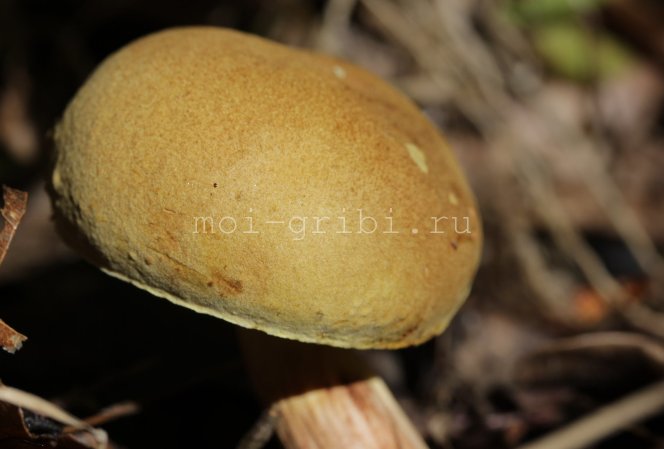
It will definitely not lead you to poisoning. True, for this you need to take into account some security measures. For example, it is only necessary to assemble a flywheel if it has no external damage. However, if external damage is still present, then in this case it is absolutely necessary to refuse the collection.
Where the collection time grows too
People who have tried the flywheel mushroom at least once are very interested in the question, where do they grow? So, if you are also interested in this, we hasten to please you. On the territory of central Russia, the mushroom mushroom is unusually widespread.
They grow in temperate latitudes, where temperatures are similar to the middle lane. They mostly prefer spruce.
Also, some varieties are also found on wood. For example, on tree trunks or on stumps.
Green flywheel can also act as a parasite. It grows on other mushrooms, such as pseudo-raincoats. It is recommended that you collect and search for green flywheels between July and October. However, in some regions, these mushrooms can be found until the end of November. However, the older the mushroom, the more likely it is to lose its flavor and health benefits.
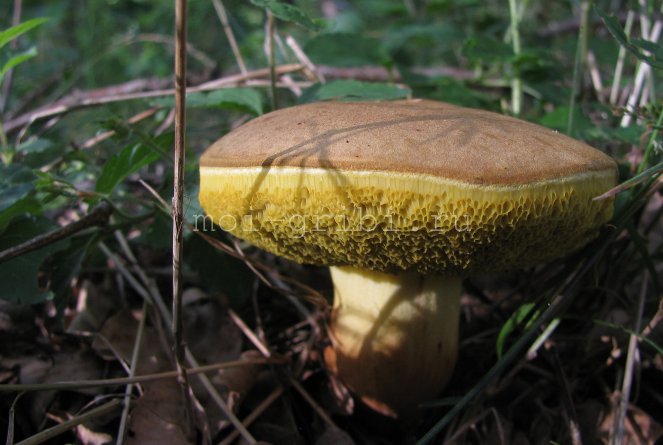
False doubles
The green mosswheel has twins, the differences between which are clearly visible in the photo. How to distinguish between these types:
| Name | Hat and hymenophore | Leg | Danger |
| Flywheel green | Brown with a greenish tint | Cylindrical, with a dark mesh | Edible |
| Motley moss | The hat is burgundy, brown, ocher, cracks, and there is a pinkish tone in the cracks | Clavate, below the belts of gray on a red background | Edible |
| Half white mushroom | The pores of the tubular layer are very small | Thick massive, light yellow color, no mesh | Edible |
| Flywheel dark brown | Dark hat from yellow to brown and olive | The dark mesh is clearly visible, the color is olive, yellowish | Edible |
| Pepper mushroom | Copper-red, turns red when cut | The color completely matches the tone of the hat | Inedible, but not poisonous, has a pungent taste, bitter, sometimes referred to as conditionally edible |
| Polish mushroom | Brown, chestnut, chocolate | Brownish, but lighter than the cap, without a mesh, has a pattern with strokes along the entire surface | Edible |
This species of flywheel does not have poisonous and inedible counterparts. Of the most tasteless in the basket, there may be a pepper mushroom, but it will be bitter. Fortunately, they cannot be poisoned.
Useful properties and restrictions to use
The nutritional benefits of these mushrooms are quite high, they have the following effects:
- used as a natural antibiotic, help in the treatment of inflammatory processes;
- contribute to the normalization of mucous eyes and improve vision;
- vitamins A, B, C, D, PP contained in fruits and minerals (especially molybdenum) restore the normal functioning of the thyroid gland;
- improve the condition of nails and hair;
 General information about the flywheel
General information about the flywheel
B vitamins contribute to the renewal of nerve cells;
frequent use of these mushrooms reduces the risk of atherosclerosis, helps to remove toxins and toxins, strengthens the immune system, renews the blood;
help to follow a diet (the calorie content of the product is 19 kcal per 100 g);
a large amount of protein in mushrooms restores athletes' strength and builds up their muscle mass.
With all the positive properties of mushrooms, one should not forget that mushrooms are a heavy food. It is not recommended for people with problems of the gastrointestinal tract and digestive glands.
Dark brown flywheel (Latin Boletus ferrugineus)
Name The flywheel is dark brown.Latin name: Boletus ferrugineus.Other names: Chestnut mosswheel, brown mosswheel.Department: Basidiomycota.Class: Agaricomycetes.Order: Boletovye.Family: Boletovye.Genus: Bolet.Conditionally edible mushroom.
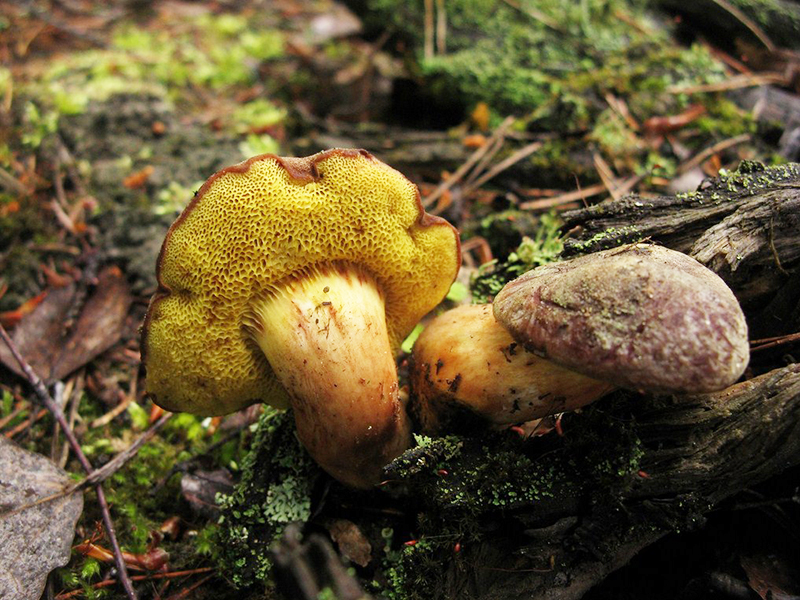 Name The flywheel is dark brown.Latin name: Boletus ferrugineus.Other names: Chestnut mosswheel, brown mosswheel.Department: Basidiomycota.Class: Agaricomycetes.Order: Boletovye.Family: Boletovye.Genus: Bolet.Conditionally edible mushroom.
Name The flywheel is dark brown.Latin name: Boletus ferrugineus.Other names: Chestnut mosswheel, brown mosswheel.Department: Basidiomycota.Class: Agaricomycetes.Order: Boletovye.Family: Boletovye.Genus: Bolet.Conditionally edible mushroom.
Leg
40–70 mm long, 10–20 mm thick, cylindrical or clavate, not hollow, hard and very tough, yellowish at the cap with a transition to reddish brown at the base.
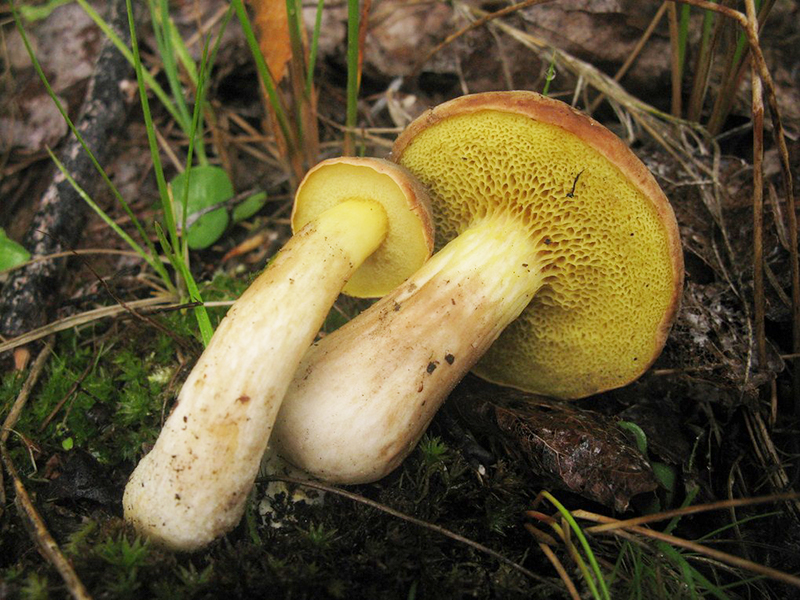
Hat
30–90 mm in diameter, convex silt closer to widespread in adulthood, yellowish-brown or olive, slightly velvety skin, often cracks in old age in dry weather.
Hymenophore
Tubular, notched or slightly descending, turns blue when damaged, the tubes are yellow, turn olive yellow as they mature, the pores are the same color as the tubes, rounded, often increasing in diameter at the stem.
Dense, white, if damaged, it turns a little pink in the caps, the smell and taste are not noticeable.
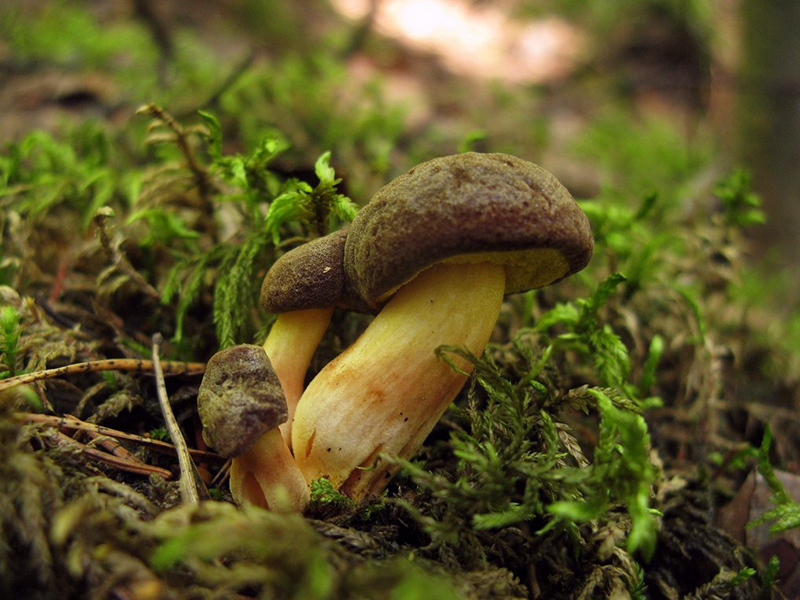
Habitat
Grows in mixed or coniferous forests on the ground, singly or in groups, prefers acidic soils, forms mycorrhiza with various trees such as birch, pine, oak.
Similarity
Possibly confused with Green Moss (Boletus subtomentosus).
|
December |
January |
February |
|
March |
April |
May |
|
June |
July |
August |
|
September |
October |
November |
Conclusion
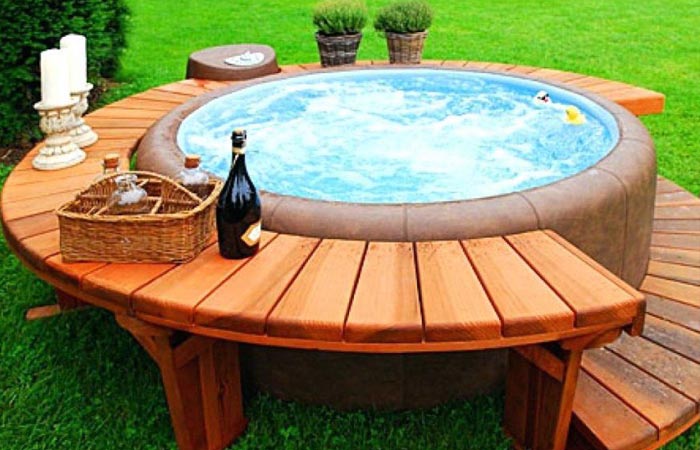
Making a hot tub with your own hands for a bath is not as difficult as it might seem the first time. The manufacturing process is in many ways similar to the cooper's one, with the only difference that most of the parts still have to be adjusted and "licked" in size with great care. It probably makes sense to try, if possible, save a few hundred dollars.
In conclusion, it should be noted that installing an outdoor jacuzzi is an excellent solution for owners of country houses and summer cottages. With him, you can have fun with friends and family members, combining business with pleasure.
A heated outdoor hot tub today is considered the most serious competitor to the classic sauna with a steam room. According to reviews, the effect of such bathing and water procedures resembles the result of visiting a Turkish hammam, but without the attendant risks of breathing in very humid hot air. Moreover, the investment in this kind of rest is relatively small in comparison with the construction of a full-fledged bath.

